Barn Door Bypass Hardware That Will Fit Any Door Thickness
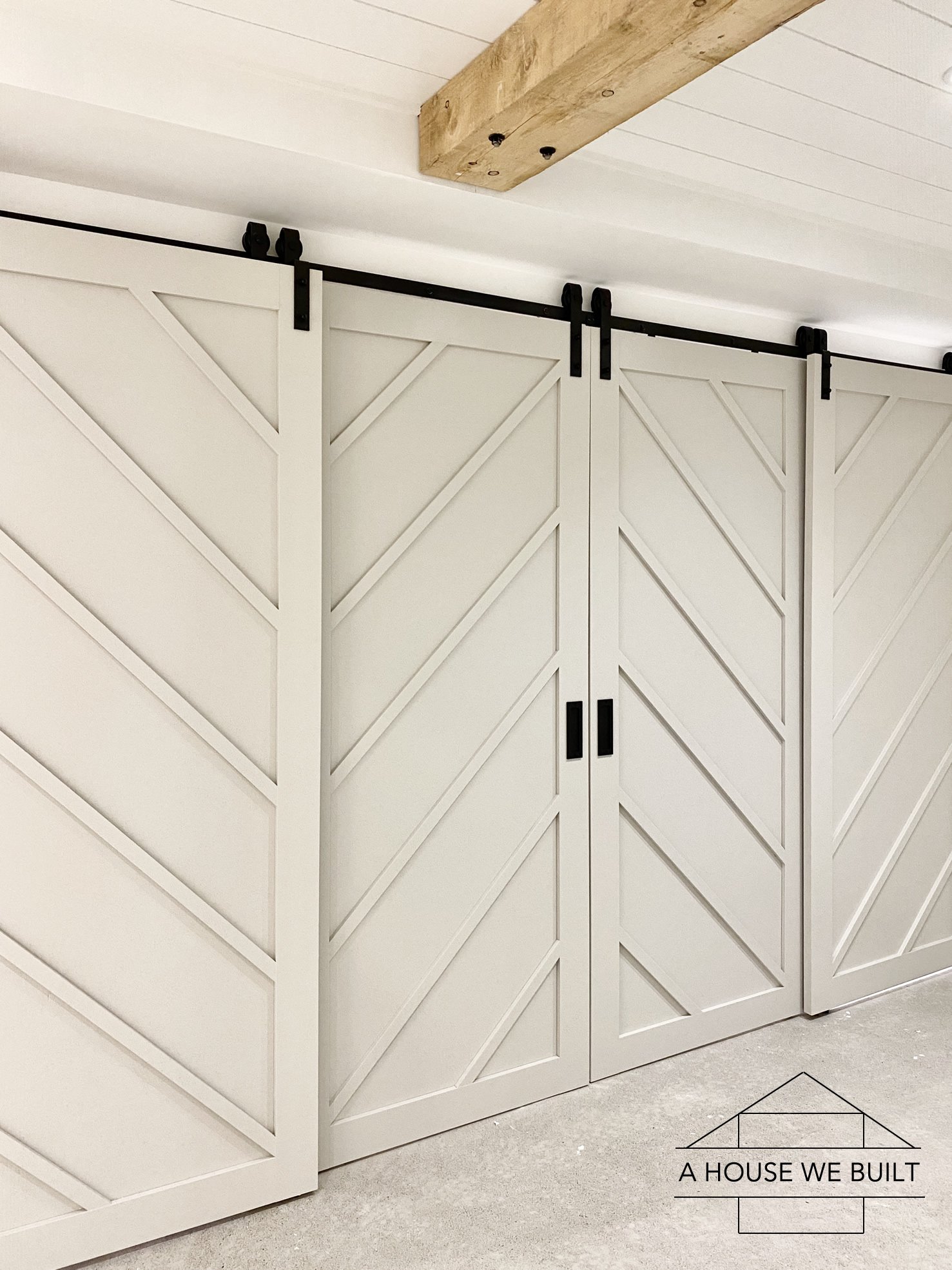
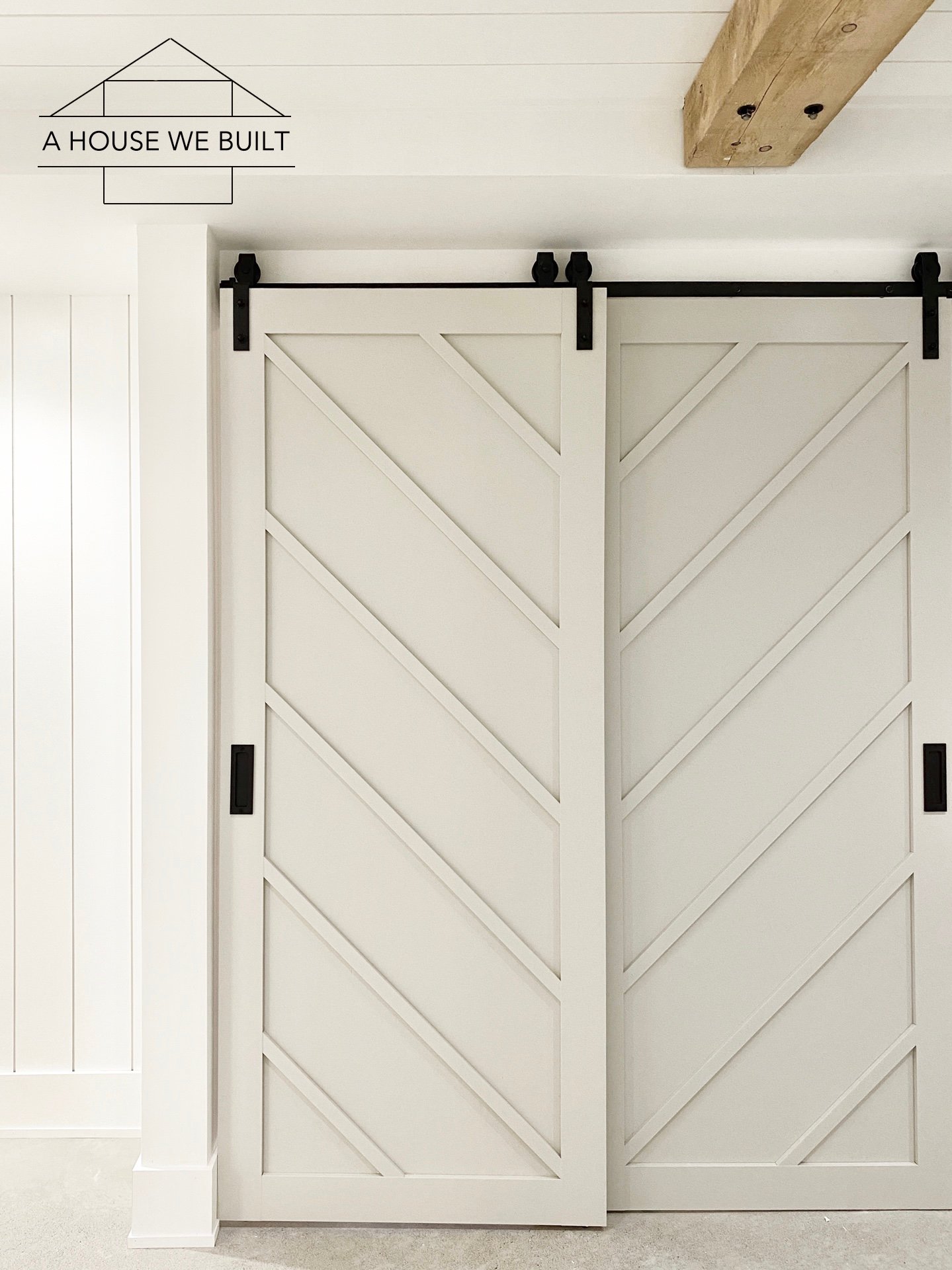
Nosotros built vi barn doors in five days for our basement and in this tutorial I'm going to share how we made them forth with a actually important tip that makes all the difference in creating a cohesive and balanced look in bypass barn doors. In full for this projection, we built 6 barn doors: 4 double bypass barn doors for our basement, as well as 2 other unmarried doors we used in our master cupboard entry. And yep, all of the 4 bypass barn doors pictured above are fully functional doors (meaning none are fixed in place).
At that place are many different ways to build barn doors simply the procedure simply breaks downwardly into two parts: Commencement is the hardware (rail, hangers, fasteners etc). 2d is the door (ordinarily a backer board plus trim).
After edifice 6 doors, we became veryyyy good at this process. I'grand pretty sure I could build a barn door in my slumber at this point. For some context, it took us four full days to build the start four doors, merely the second two doors nosotros fully congenital and painted and hung in less than 1 day! But since we'd never washed this before, we fabricated some mistakes and had some "learning experiences" and so in this tutorial, I'chiliad going to share not only how to build barn doors, but I'm also going to share what we did wrong along the way and how we fixed those things so hopefully you can learn both from our mistakes and our successes.
Our gray paint colour is BM Revere Pewter.
Step ane: DESIGNING YOUR Befouled DOORS:
I chose to do repeating and reversing chevron pattern across all four of our barn doors. And then, each door alone was asymmetrical only once all the doors were hung side-by-side, they created a chevron pattern.
Below was my original design concept for our doors (I say "concept" because this was what I by and large wanted the doors to look like, but information technology was non the practical representation of how they'd marshal):
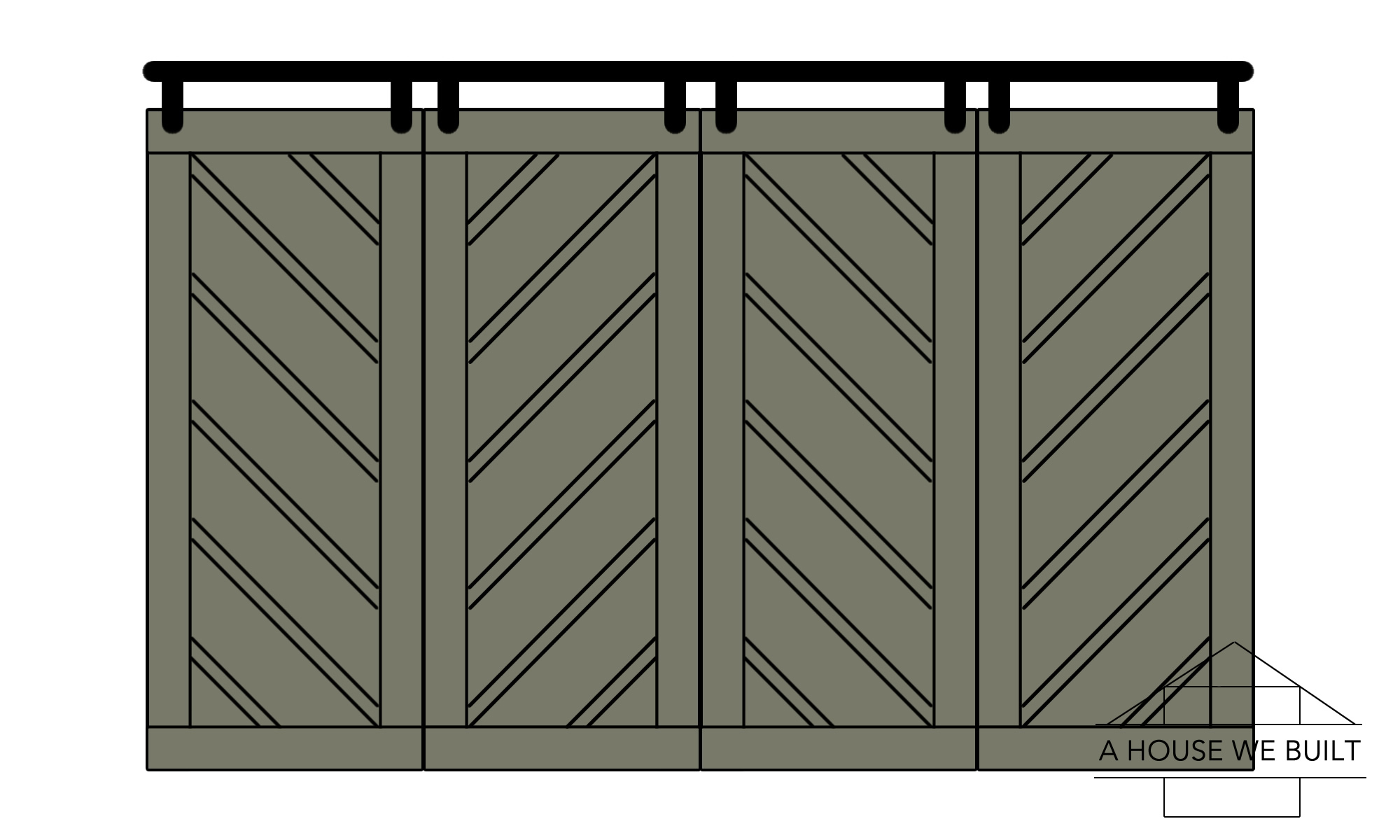
However, we chose a single runway double bypass hardware arrangement, and so our final design is shown below. All four doors nosotros built on our bypass track are fully functional (none of them are fixed in place) and then each of them pb somewhere and each of them can be opened by sliding in front end or behind each other.
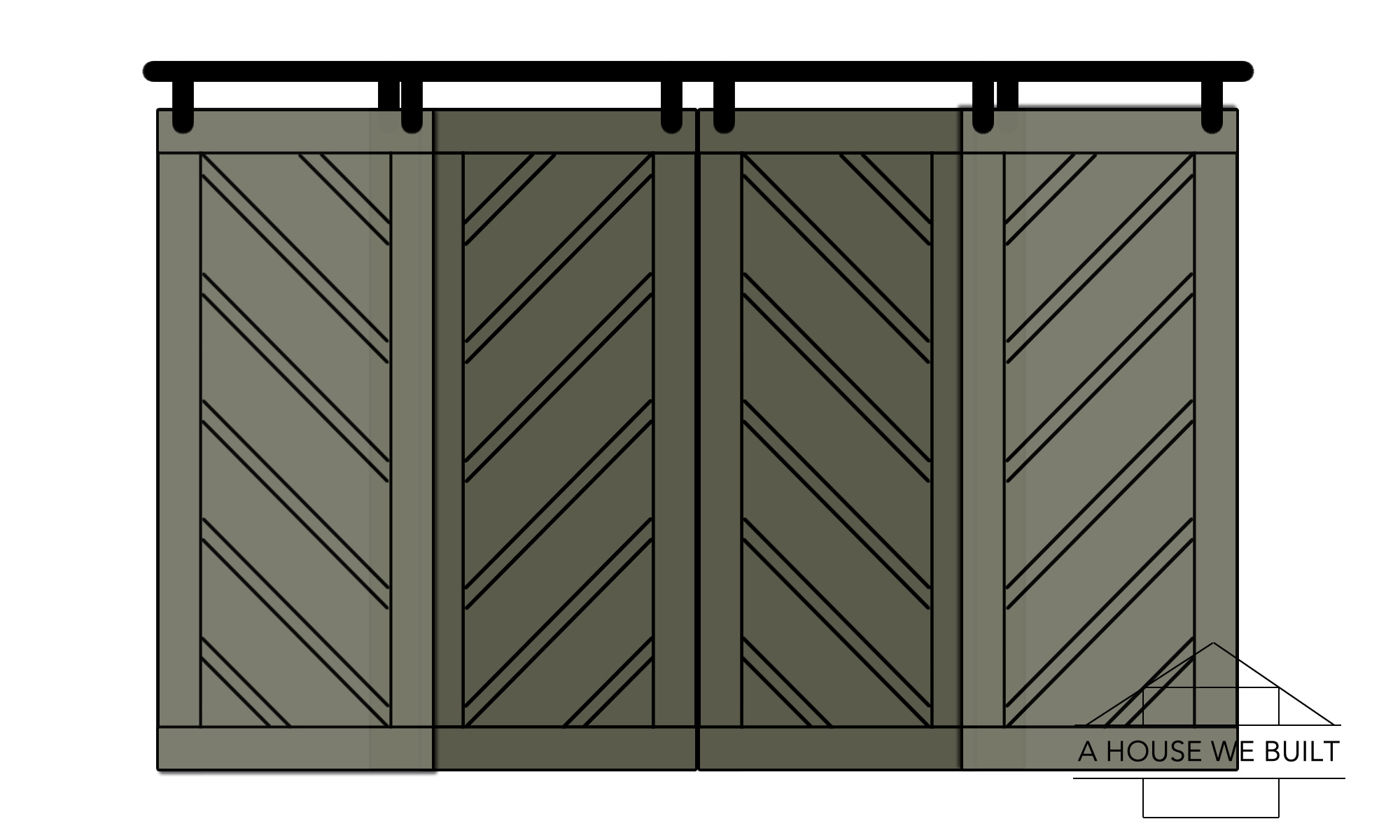
Each of the doors is actually different than the other. The graphic below breaks it down, and the reason why is fully explained at the bottom of this tutorial under "Accounting for Overlap in Bypass Barn Doors".
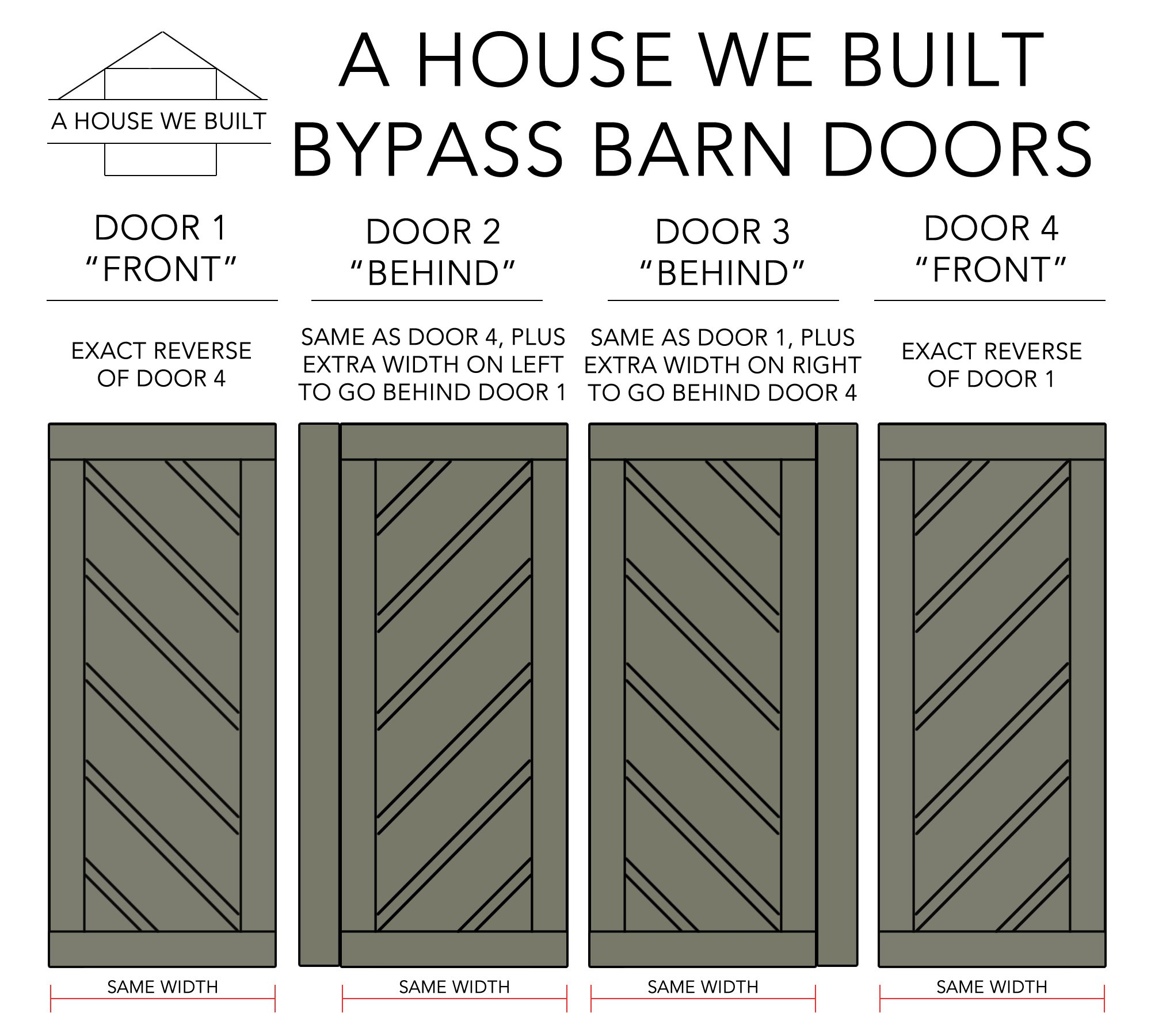
Our doors are most iii.v′ wide x 8′ tall and nosotros did 45 degree angles everywhere.
STEP 2: CHOOSING Befouled DOOR HARDWARE:
If you choose to practice one barn door alone, or two barn doors just abreast each other (without the power to slide behind each other), then you have 2 options:
- For i barn door lonely, you lot only need a unmarried runway plus the necessary hardware. In that location are lots of different styles available out there, simply this is my favorite style: Amazon | Abode Depot.
- For two barn doors side-by-side, you need something like this: Amazon | Home Depot.
If you lot choose to exercise bypass barn doors as we did (significant that the doors tin slide in front end of or behind each other), then you lot have 2 options:
- A double track bypass system like this: Amazon | Home Depot
- A unmarried rail featherbed organization like this: Amazon | Walmart (the style type we chose)
So, we chose to practice a single rail bypass organisation with all 4 barn doors hanging off one track. Pregnant that two doors are "in front" and two doors are "behind". The "behind doors" are on direct hangers, while the "front" doors accept angled hanger that lifts them to hang in front so that back doors can slide behind them.
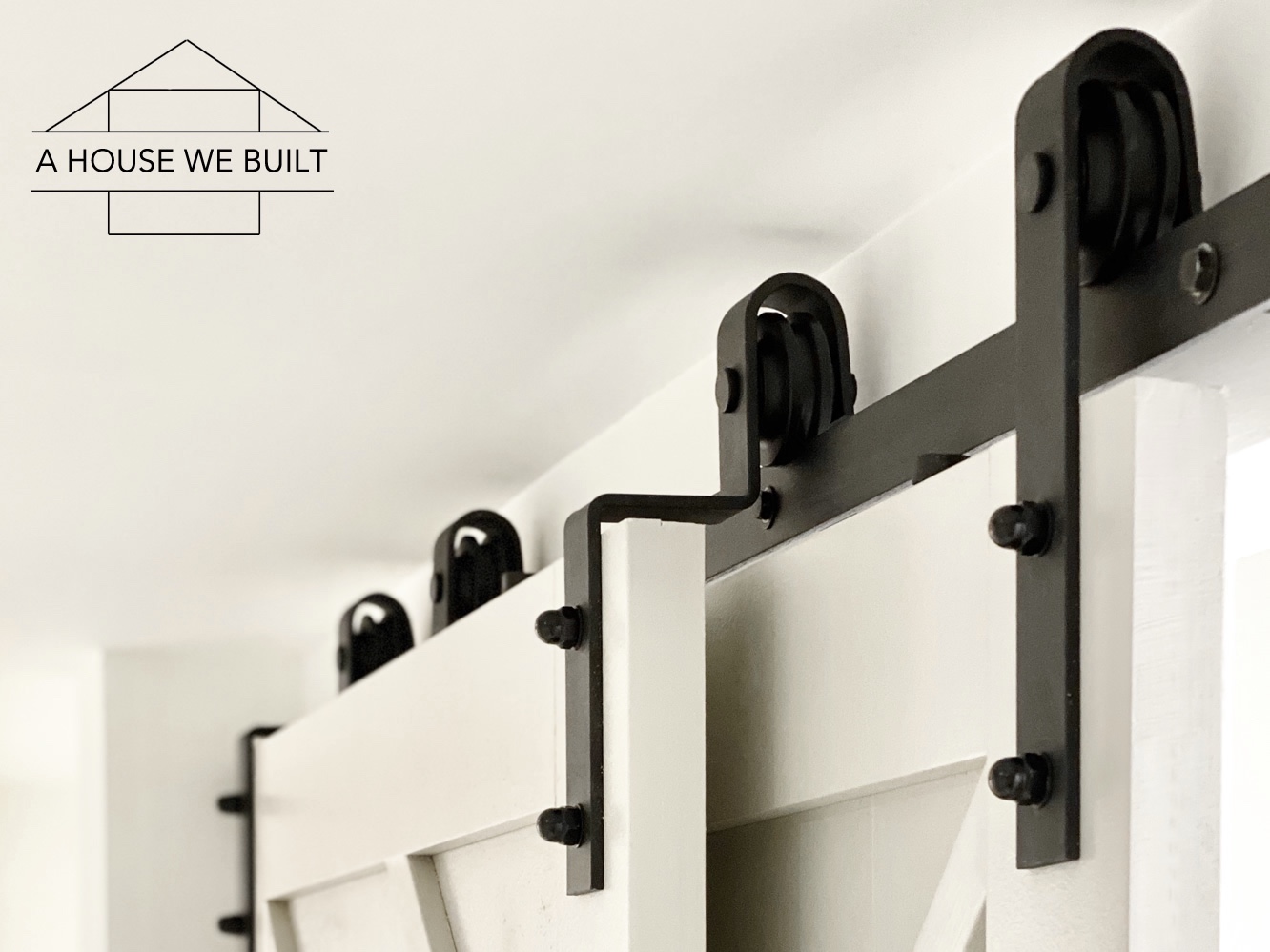
With this (and any) 4-door bypass system, you next have to pick which doors are "front" doors and which doors hang "backside" and there are 4 configurations you can cull from:
Choice A = Door 1: In front | Door two: Behind | Door iii: In front | Door four: Behind
Option B = Door i: Behind | Door ii: In front | Door 3: Behind | Door 4: In front
Selection C = Door 1: Backside | Door 2: In front | Door iii: In front | Door 4: Backside
Pick D = Door 1: In front end | Door 2: Behind | Door 3: Behind | Door 4: In front
We chose Option D considering, in our hallway, Doors 1 & 4 will be our nigh-used doors so we wanted them to hang in the front. Besides I'm personally drawn more than to the symmetry of Options C & D overall.
MATERIALS LIST FOR BARN DOORS
Note ane: the "trim" materials you need volition differ based on your door design. I've listed the materials we needed for our door design only a different door design will naturally require different trim materials.
Note two: I used primed MDF trim since I planned to pigment my doors. If you plan to stain them instead, then you volition demand to use existent wood trim.
Raw materials for Doors 1 & 4, or our "Front Doors" (so we needed this x 2):
- 1 x 3/iv″x4'x8′ sanded plywood backer board cut down to size, per door
- 3 x 1″x5″x8′ MDF trim around the perimeter of each door, per door
- 3 ten 1″x2″x8′ MDF trim for the slanted battens, per door
Raw materials for Doors 2 & iii, or our "Behind Doors" (so we needed this 10 2):
- 1 ten iii/4″x4'x8′ sanded plywood backer board cut down to size, per door
- 3 x 1″x5″x8′ MDF trim around the perimeter of each door, per door
- 3 x 1″x2″x8′ MDF trim for the slanted battens, per door
- ane x 1″x6″x8′ MDF trim to embrace the extra width, per door *
* This is explained in the "Bookkeeping for Overlap" section of this tutorial beneath.
SUMMARY OF ALL RAW MATERIALS NEEDED FOR OUR 4 Befouled DOORS:
* Our doors are approximately 3.five ft x eight ft. TOOLS NEEDED TO BUILD THE DOORS: OTHER MATERIALS NEEDED: ACCESSORIES: Befouled DOOR HARDWARE KITS:
* Our hardware is custom but we did a single runway featherbed with four doors.
HARDWARE MOUNTING TIPS:
- You must accept some kind of back up/beam on/in your wall to mount your track on. We designed and built this function in our basement with the intention of having barn doors here then we did in a structural beam for our track to hang off. If yous don't have something similar that, then you may want to consider some kind of wooden header bar to strengthen where the runway hangs from because the weight of all the doors volition hang off this so information technology can't just exist screwed into drywall.
- Follow the mounting directions on the hardware kit yous get because each one volition be slightly different. For our bypass track though substantially it was simply bolted to the wall with offsets.
- Make certain your runway is level!!!!!! This is seriously so, and so, so, so, so important.
- Mount the track to your wall earlier y'all accept your final door measurements.
BARN DOOR BUILDING INSTRUCTIONS:
Note 1: these instructions can apply to whatsoever barn door blueprint that is a combination of a backer lath and trim on tiptop, so these instructions are adaptable to many different barn door styles other than our pattern.
Note 2: nosotros pre-painted all private pieces before assembly. Pre-painting is just my personal preference, simply not necessary. If you don't want to pre-pigment, ignore all paint references and pigment/stain at the terminate.
Note 3: if you lot're edifice bypass befouled doors, you must read my "Bookkeeping for Overlap in Featherbed Barn Doors" tip below these instructions earlier you build anything! I merely put it at the end because it only applies to featherbed doors and if y'all're only edifice regular non-bypassing doors, then information technology'southward non relevant.
Note iv: You may notice that the timeline in my pics doesn't fully line up with these instructions and that's because on our first door (which I took progress pics of), we weren't as confident then we painted each set of trim as we cutting them instead of cut everything up front, which is how we did the rest of the doors.
- Cut the plywood backer lath downwardly to the size you want your door. (ours are approx 3.five′ x 8′)
- Utilise wood filler on whatsoever imperfections. One time dry out, sand and paint both sides. One time the get-go coat of pigment has dried, sand the unabridged surface lightly, and once information technology's smooth and so paint the second coat.
- Cut all your perimeter trim to size. The vertical side pieces are the aforementioned tiptop every bit your door panel. The short header/footer pieces are the width of the door minus the width of the side trim pieces.
- Cut your battens to size. For the first door, while nosotros were figuring out the measurements, we cut them all in half to 48″ and cut one side to 45*, and so placed them on the door and used them to measure the length. We had two crossbar sizes in total (one long, one short), so one time we determined those lengths, we merely used those battens to mark the length on all the rest of them. The start one is the hardest, all the rest are easy. Note: the battens on Doors 1 & 3 have exact contrary angles as Doors 2 & 4. (We besides created a spacer guide cut to the space between the battens.)
- Dry-fit all the trim & battens on the capitalist lath just to make sure you measured and cut everything properly and that all the pieces fit perfect equally intended earlier moving to the next step.
- Pigment all your trim & battens. I use a brush & roller because information technology's easier cleanup than a sprayer.
- Attach all the trim to your door with adhesive and nails. Kickoff with your perimeter trim (offset do the long side pieces, then the 2 shorter header/footer pieces). Next, adhere the battens.
- Wood filler all the boom holes, seams between trim pieces, and the 2 long exterior sides of the doors (where the plywood and trim meet) to visually erase all seams between boards.
- In one case dry, sand all the wood filler spots down (including the two exterior long sides of the doors), then touch up the paint where needed (I really re-rollered the meridian of all the trim with a modest roller).
- Attach the door pulls. (Nosotros did this subsequently our doors were hung but if you know where you want your pulls at this indicate in the edifice process, then you can just attach them now.)
- Attach the hangers to your doors according your hardware's guidelines. Essentially, you merely drill holes in alignment with the holes on your hangers and bolt the hangers to the door.
- Hang the doors. If you accept bypass doors, start with the "behind" doors.
- Install door stops and floor guides (should come with your hardware kit).
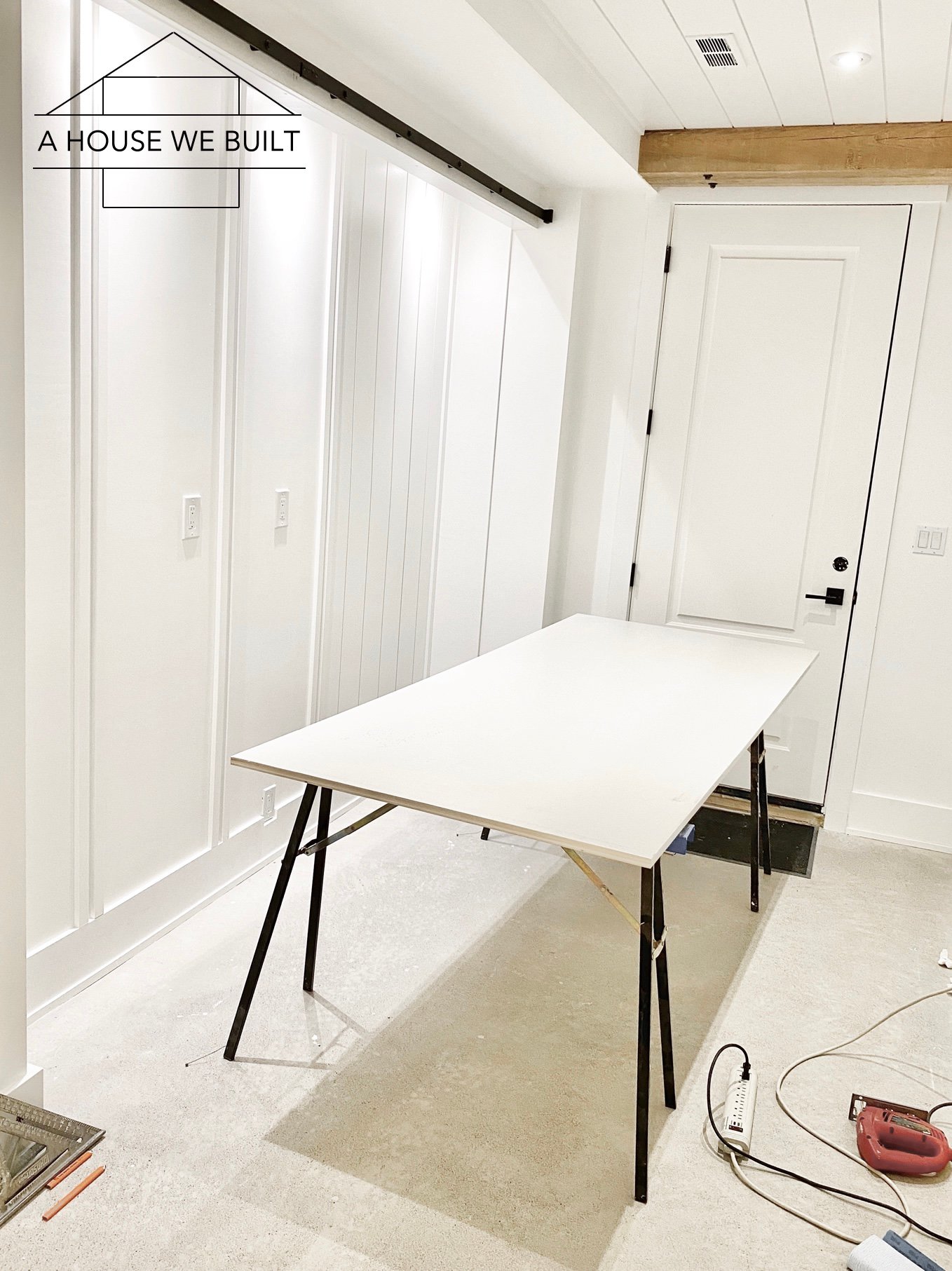
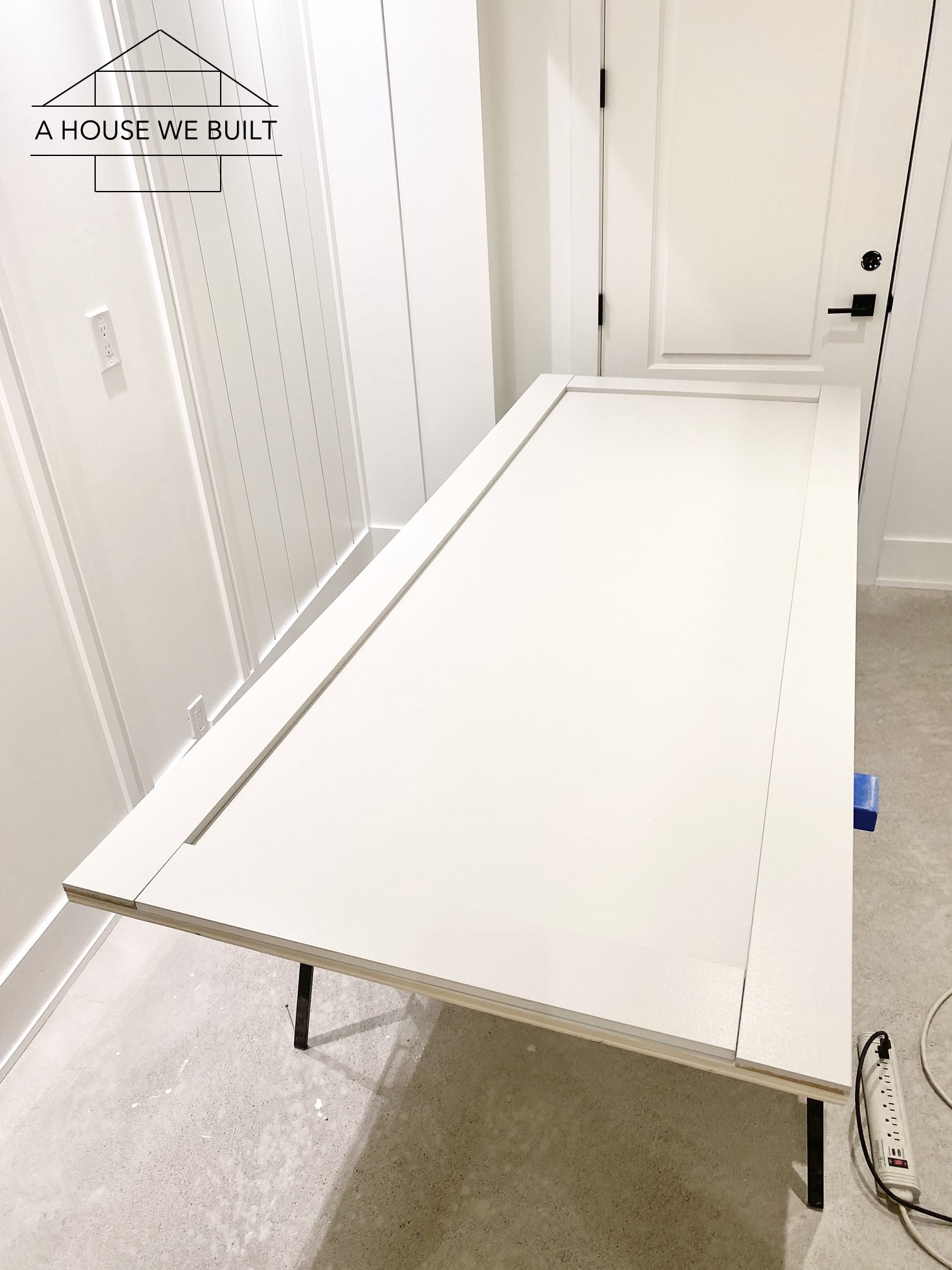
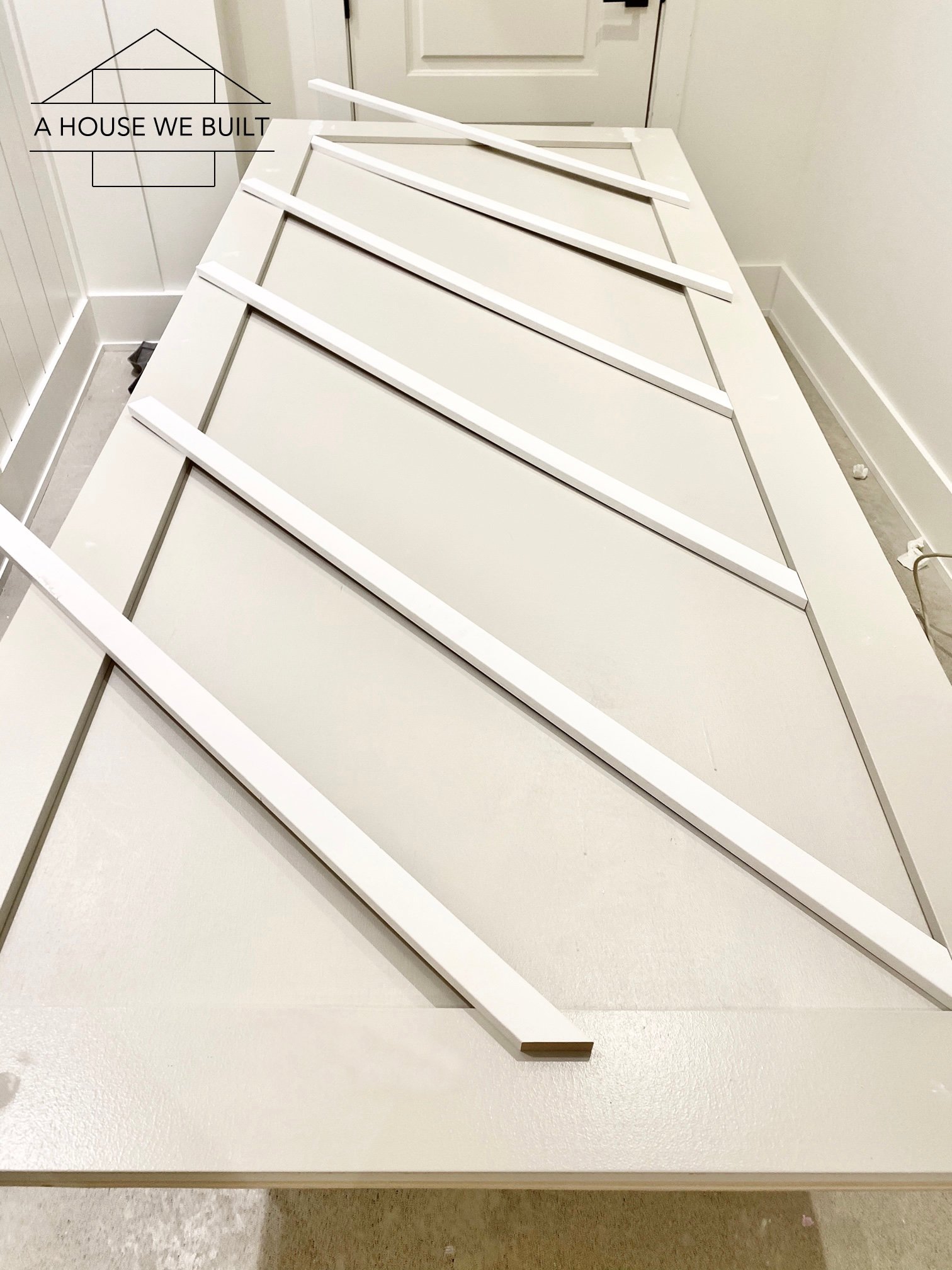
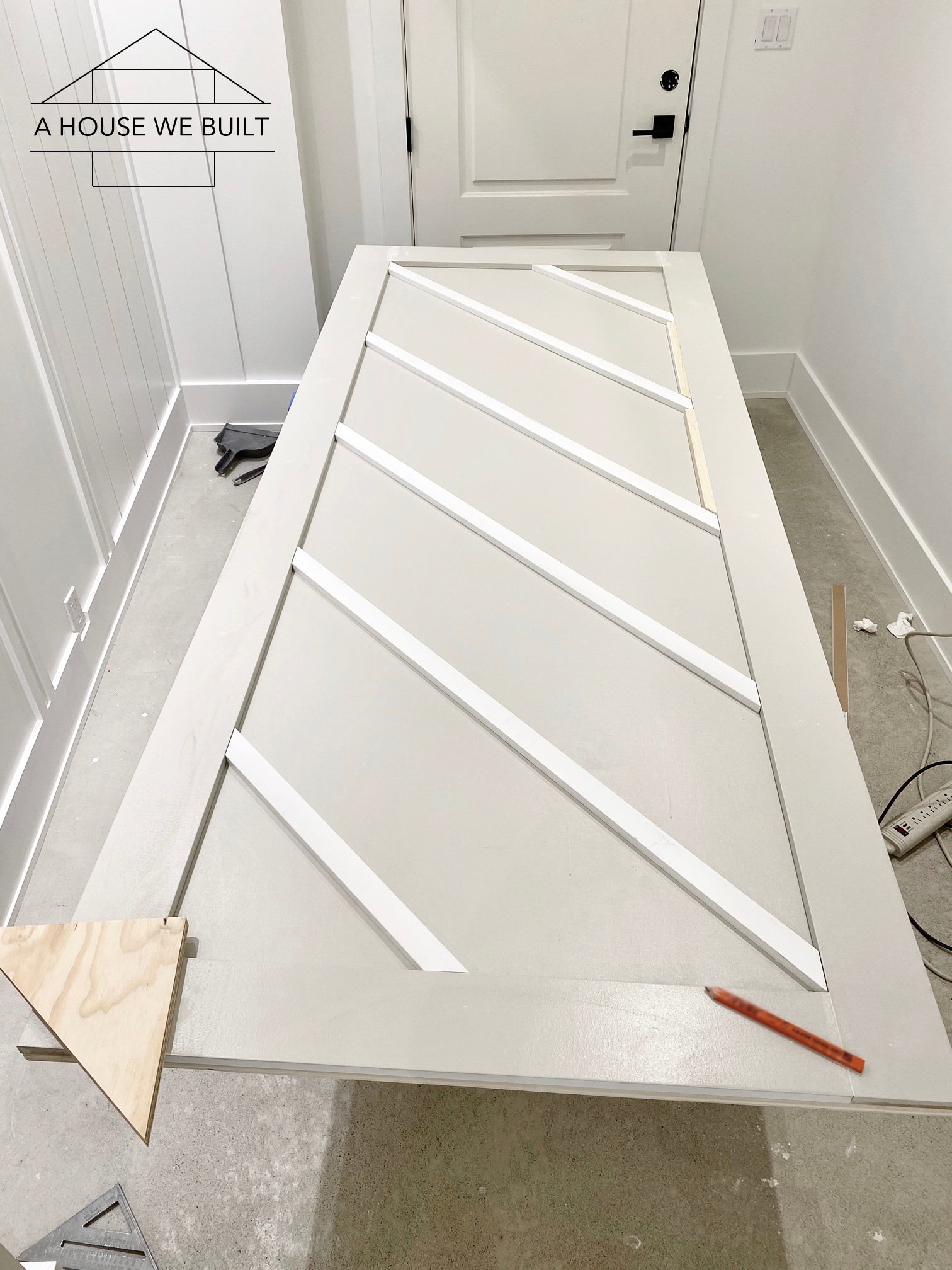
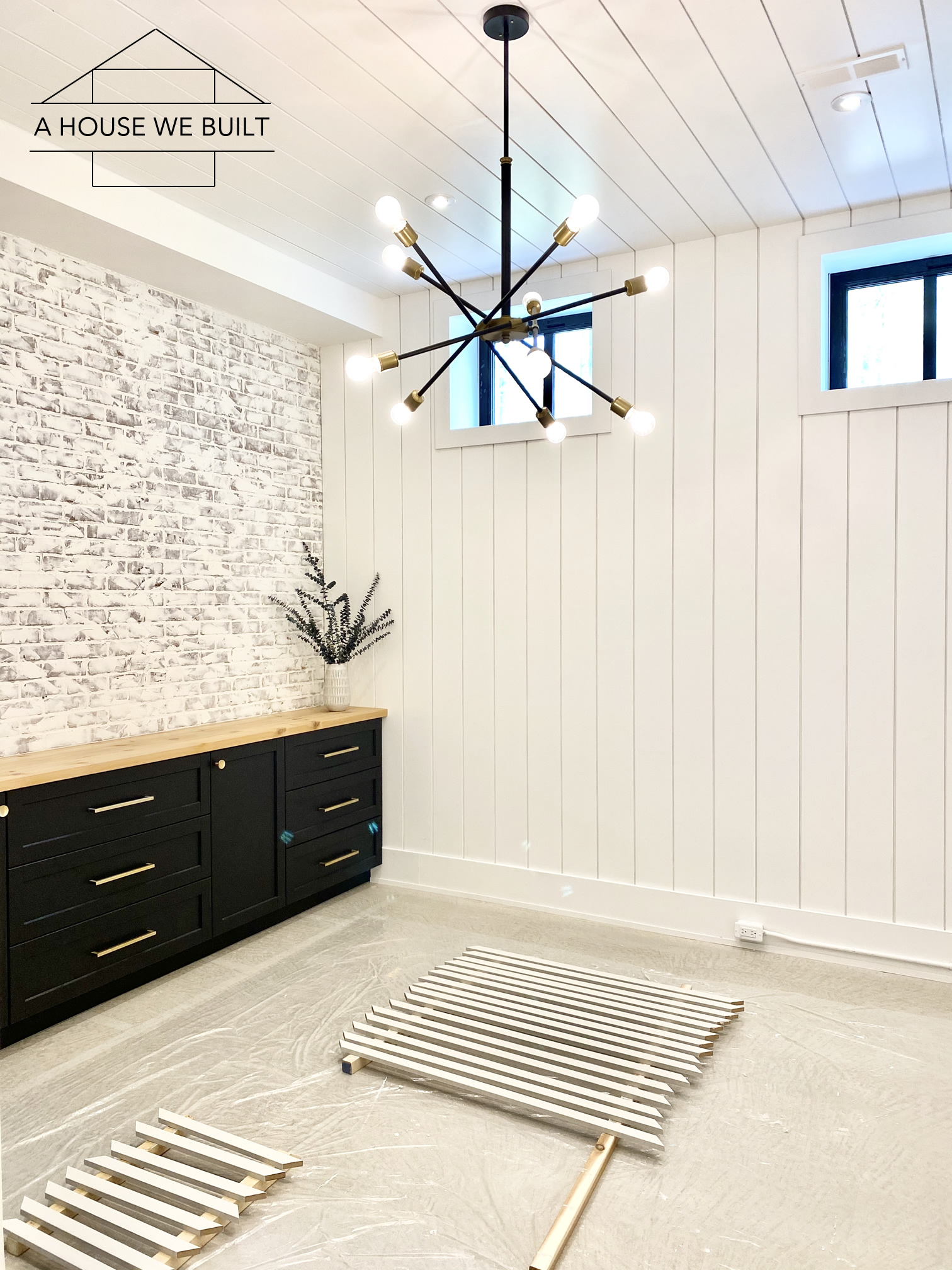
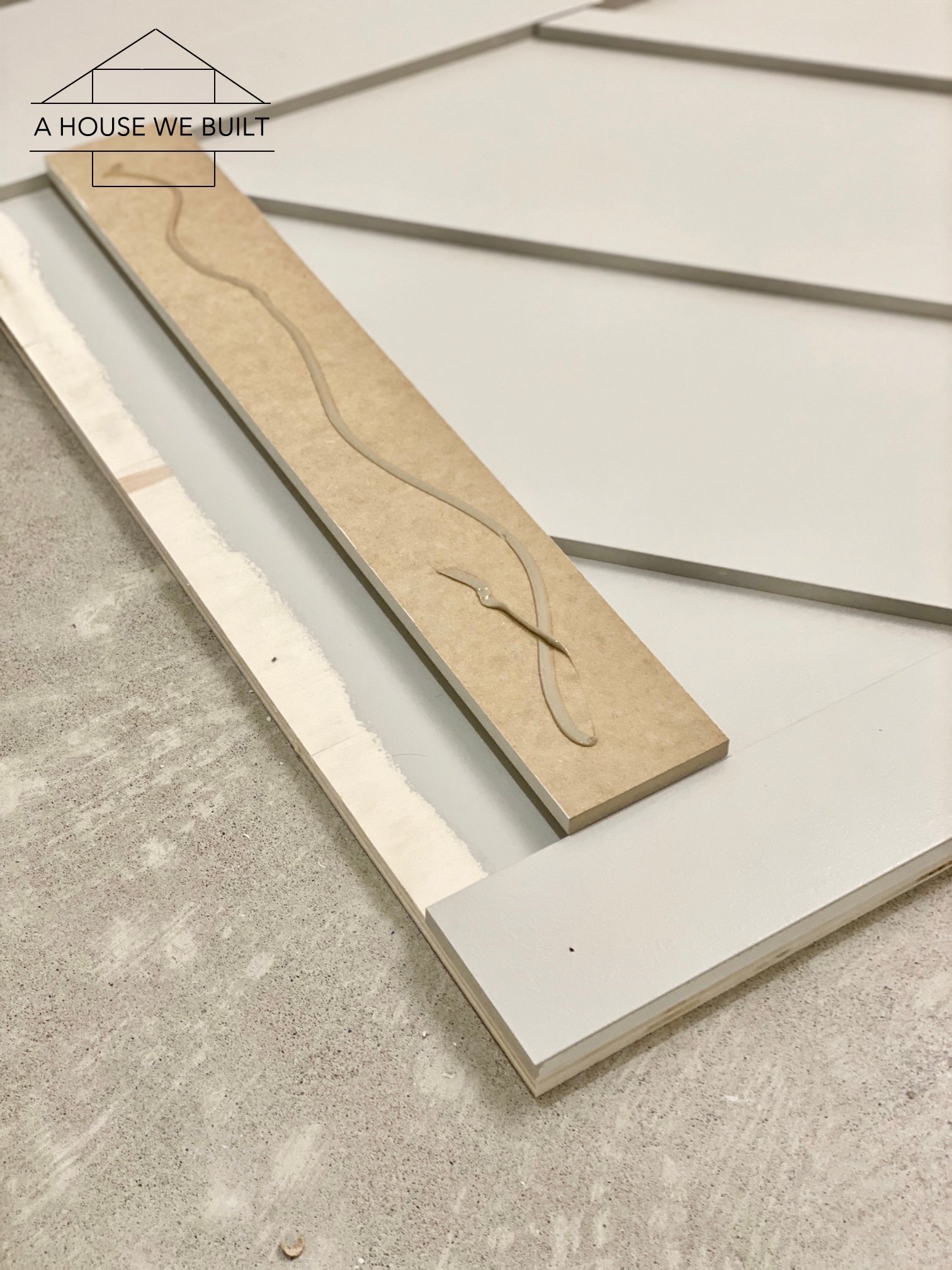
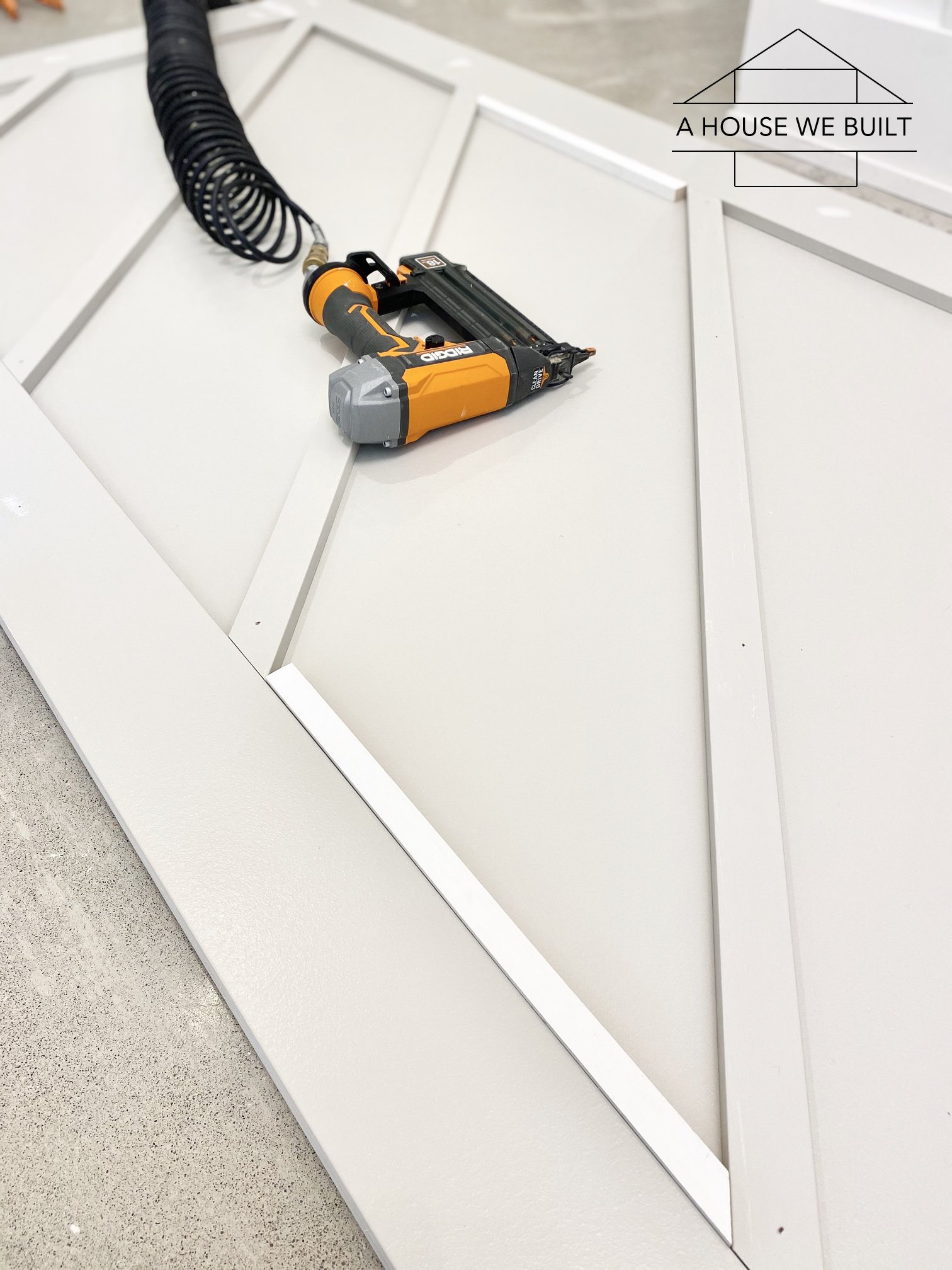
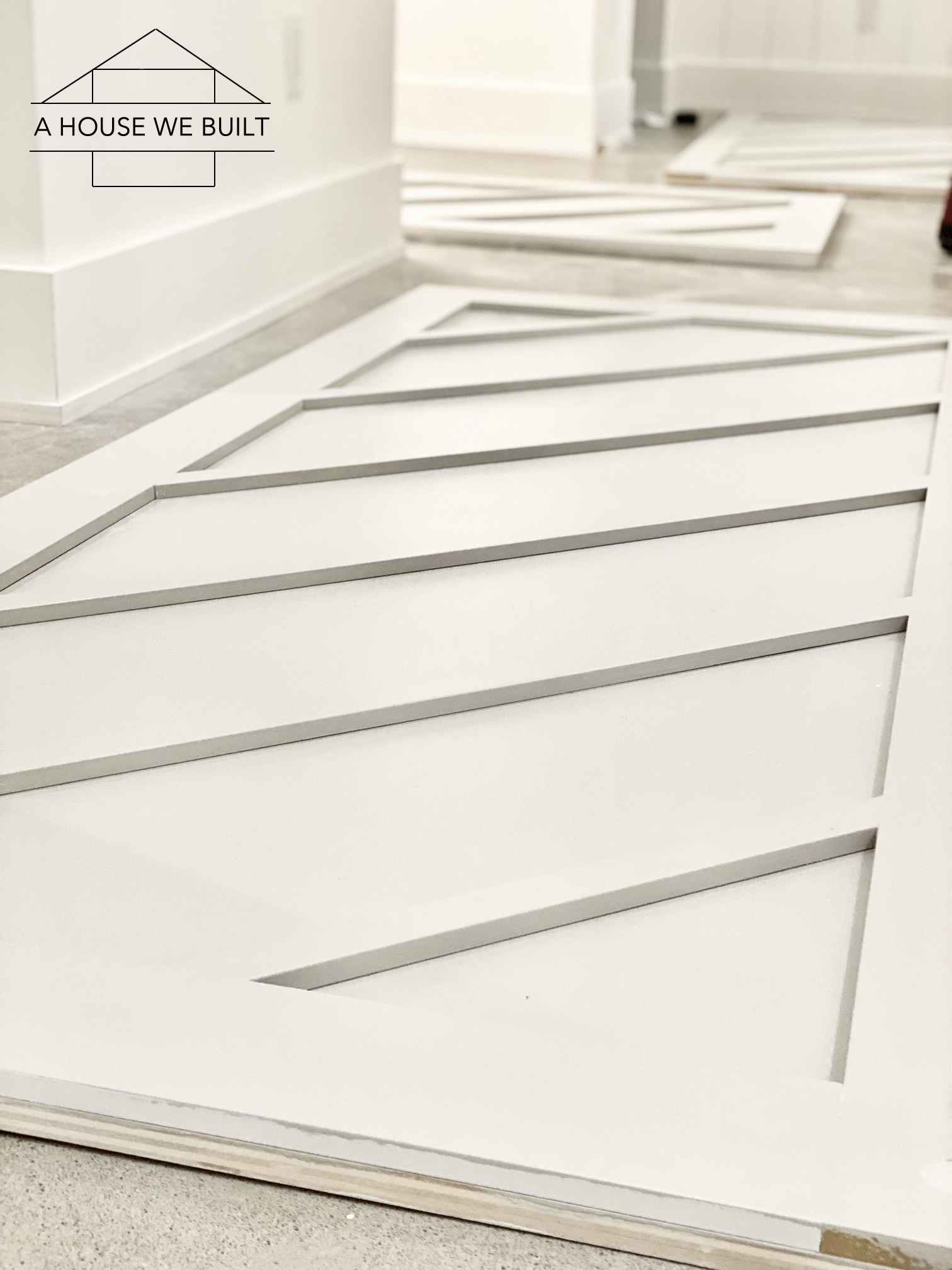
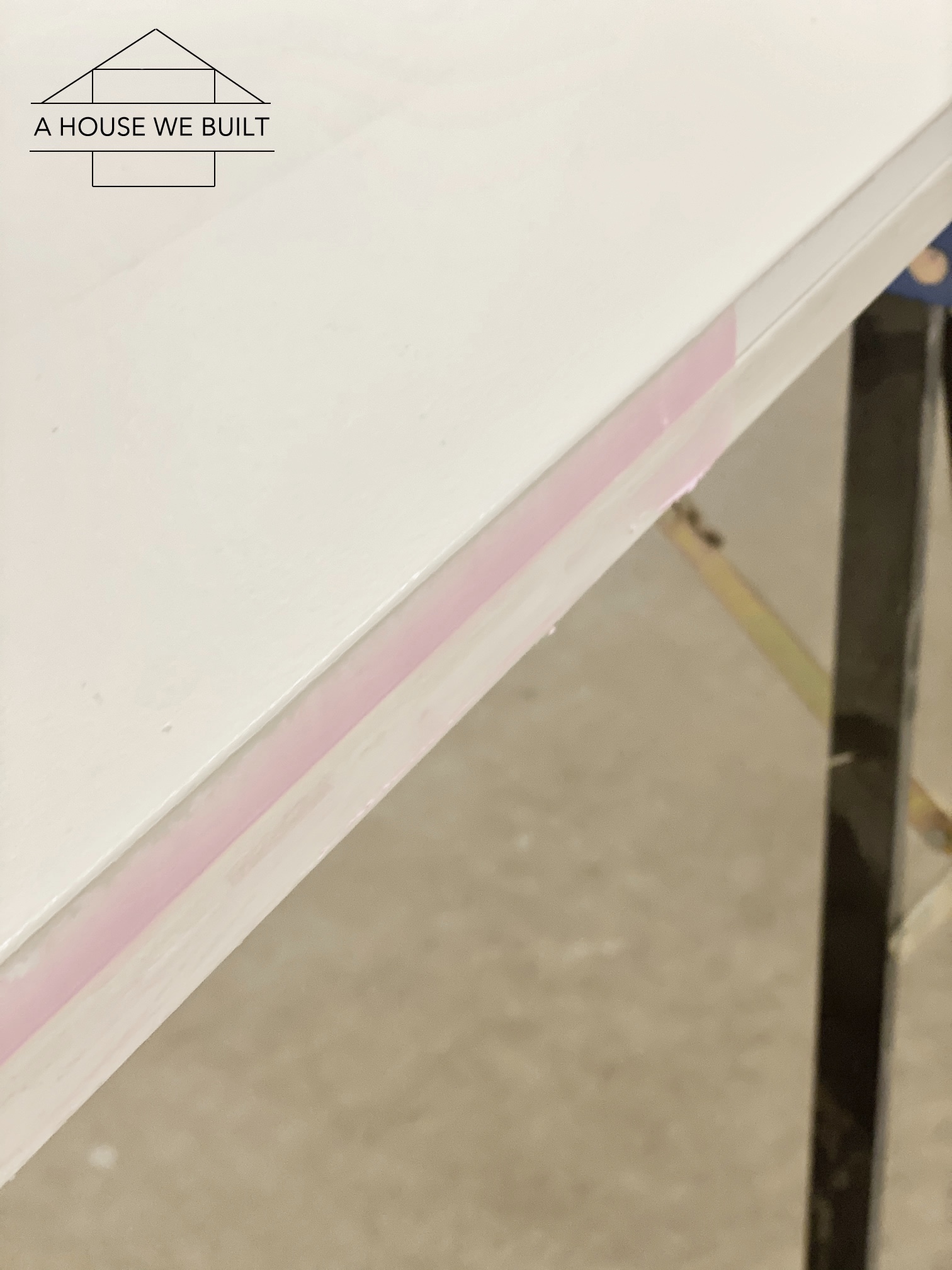
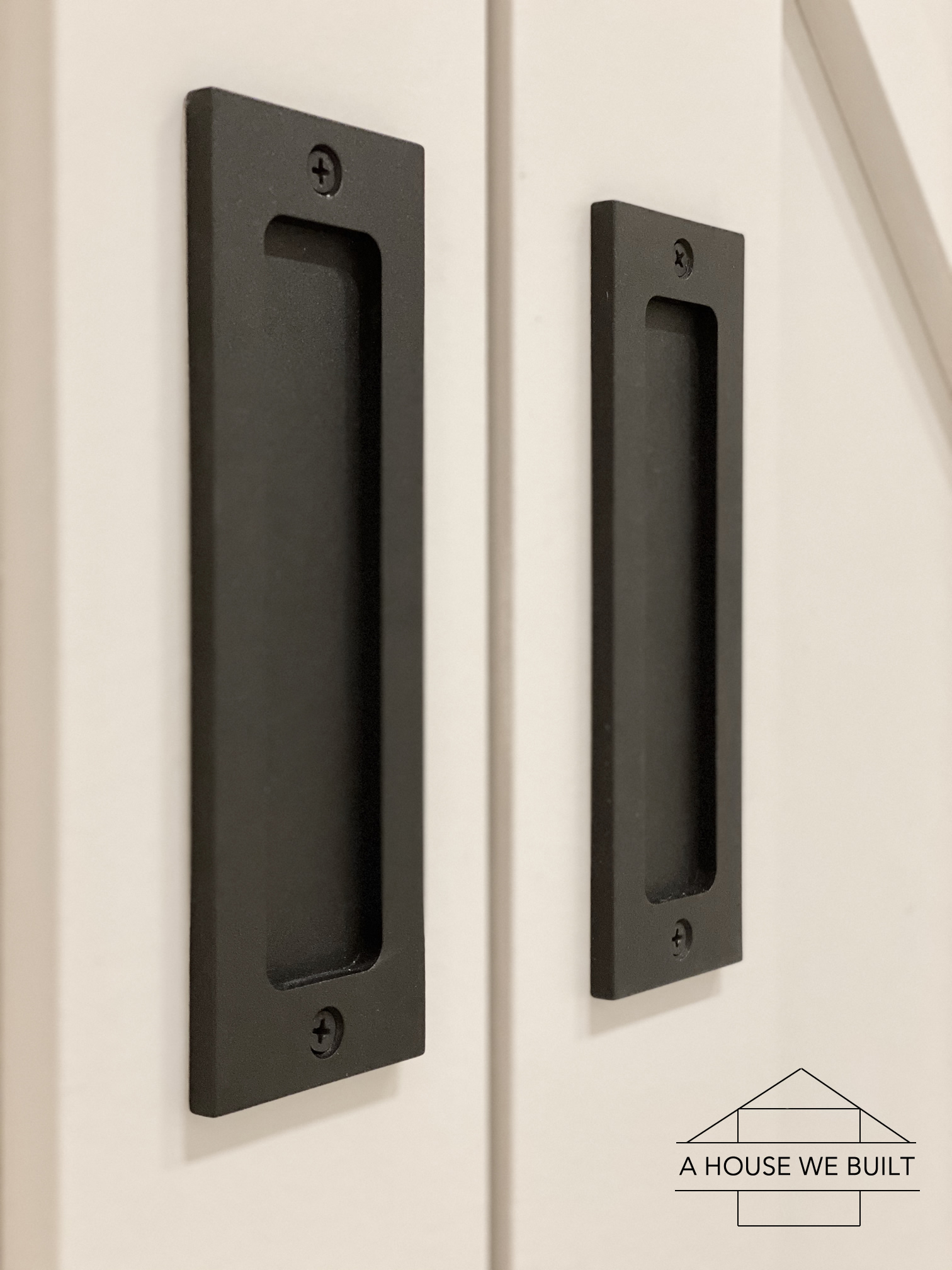
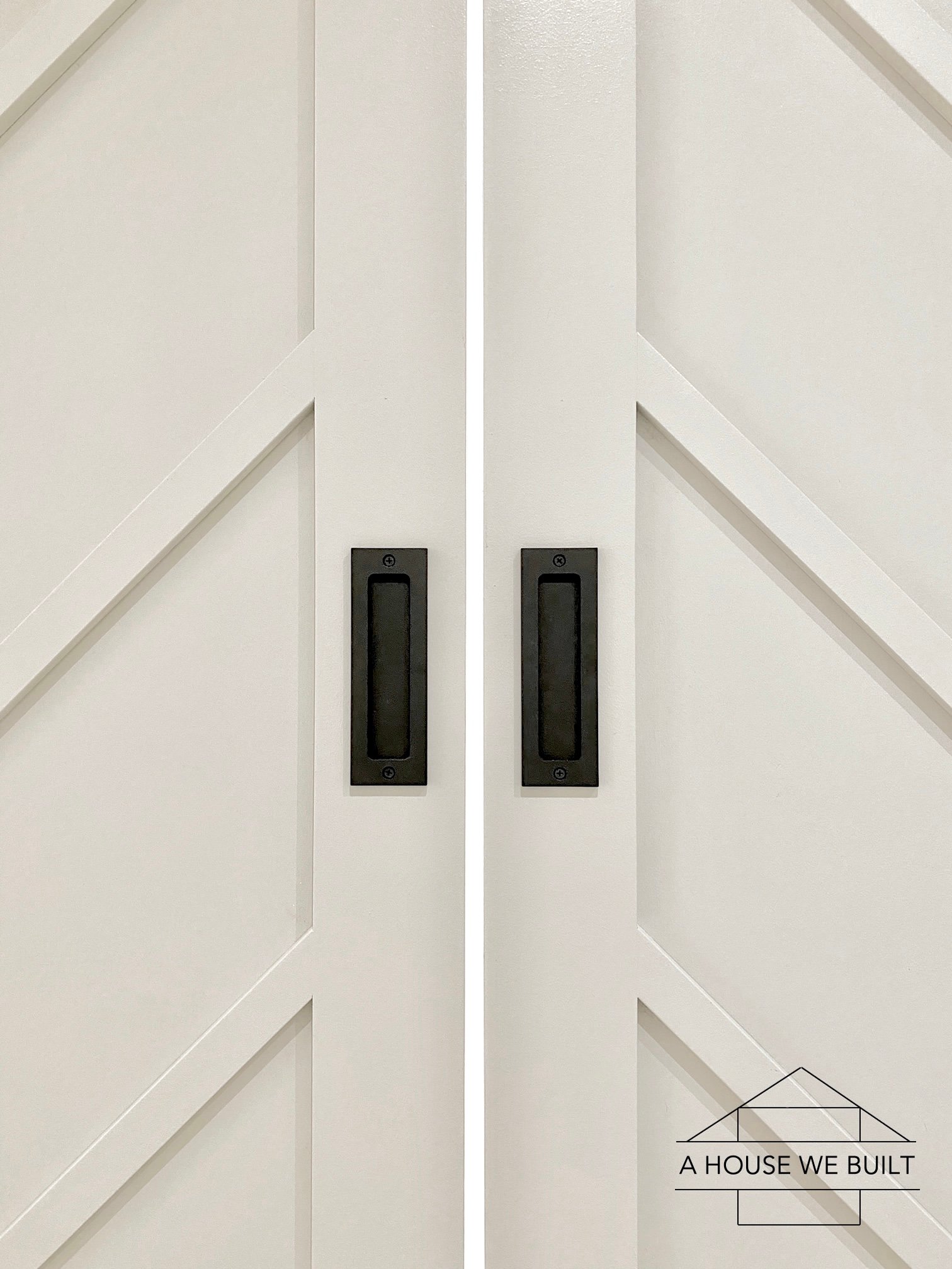
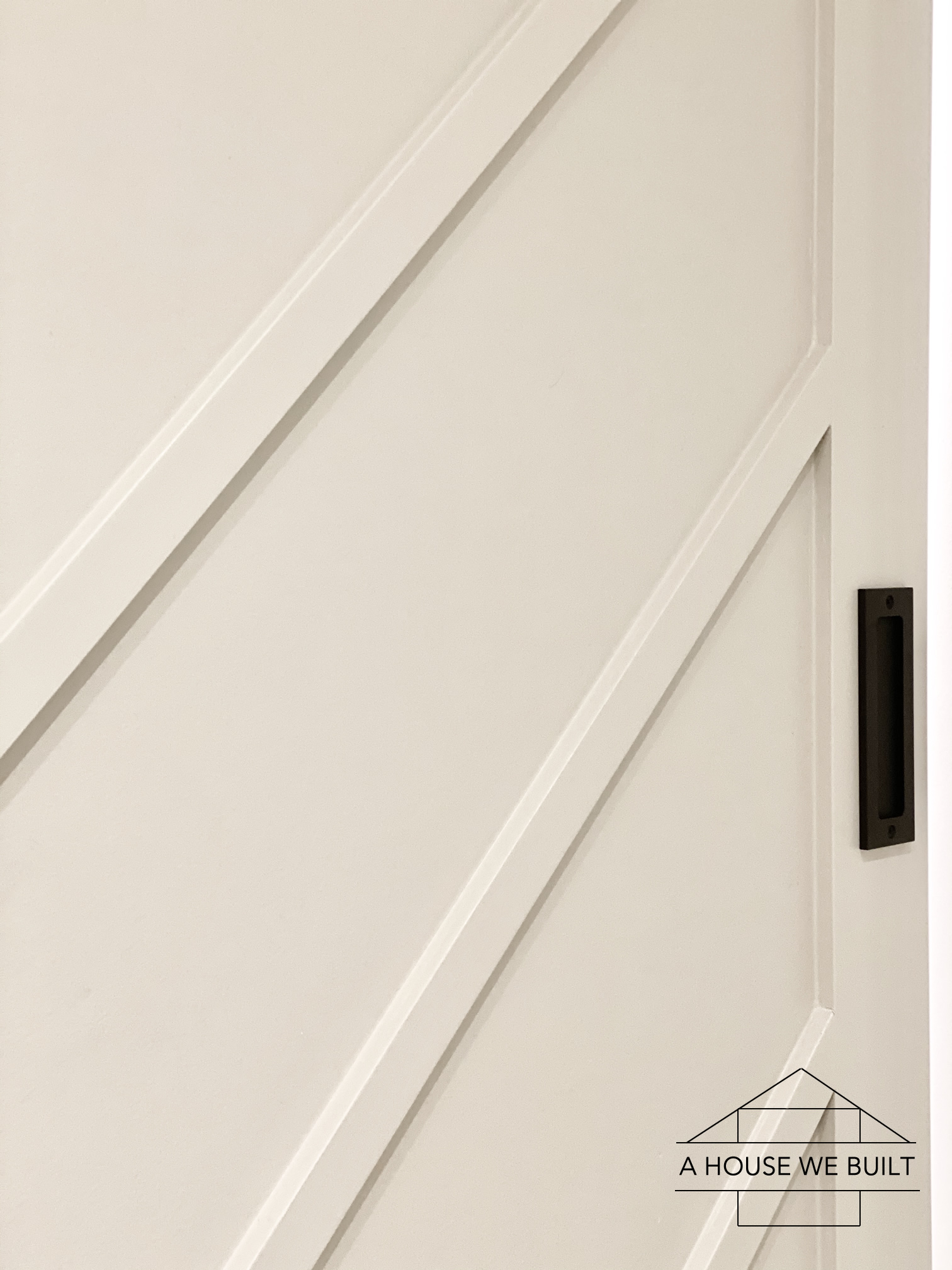
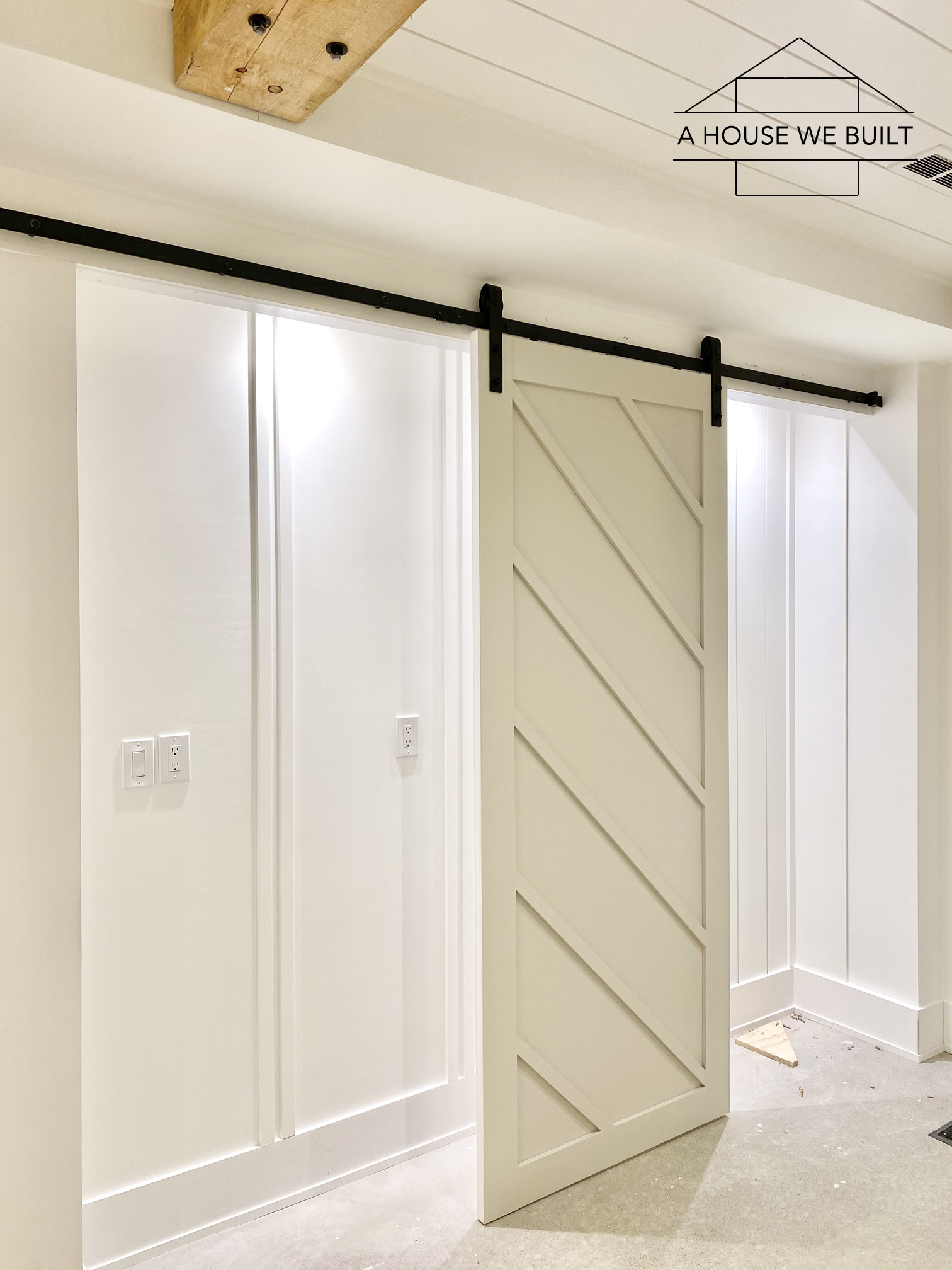

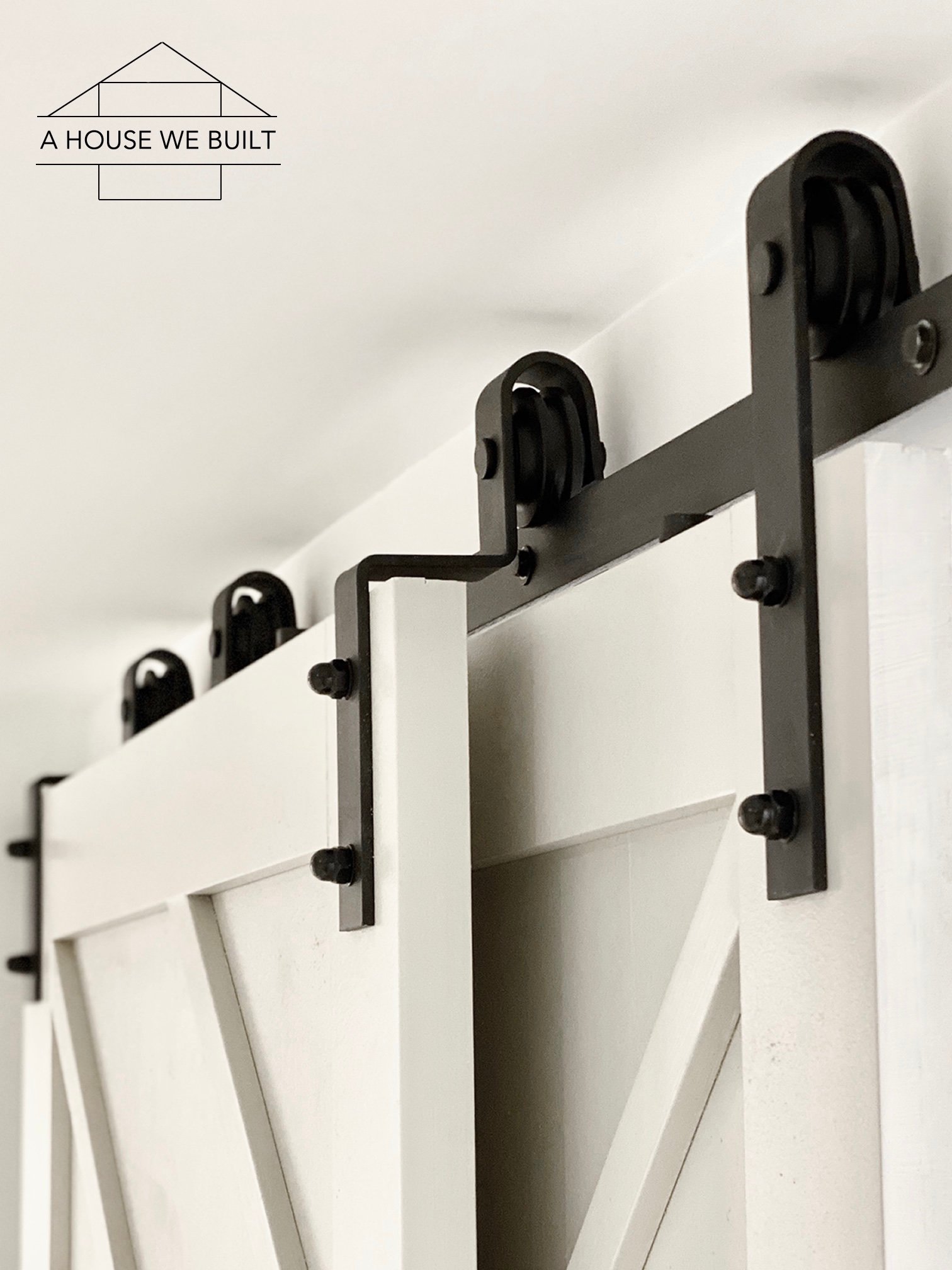
Bookkeeping FOR OVERLAP IN Featherbed BARN DOORS:
If you're edifice featherbed barn doors (especially on a unmarried track), this is VERY IMPORTANT. This is why our "backside" doors are different widths than our "front" doors. Encounter, everywhere says "do well-nigh an inch of overlap" between bypass doors simply that does not piece of work if you lot want the full design of your "behind" door to be visible from the front! This seems painfully obvious in hindsight, but I didn't see anyone mention it so I didn't consider it until after we'd congenital our first 4 doors. So I'm sharing both our mistake and our solution.
Let me explain: If y'all take the full width of your space and split up by the number of doors you're going to do, then add together one inch of overlap and build iv doors that are exactly the same size on a unmarried track bypass system, as you tin can run across in the moving-picture show below, several inches of the design on the "Backside" doors (in our case: Doors 2 & 3) are visually lost behind the "Front" doors (in our instance: Doors i & 4).
Furthermore, due to the overlap, the total width of the doors no longer covers the total width of the rail (duh, correct? *sigh*). But if you're wondering why we didn't simply build wider doors, that'south because while wider doors would solve the problem of physically roofing the infinite, the visual pattern would still be as messed upwards from the overlaps partially hiding the "backside" doors. Permit me show yous what I mean:
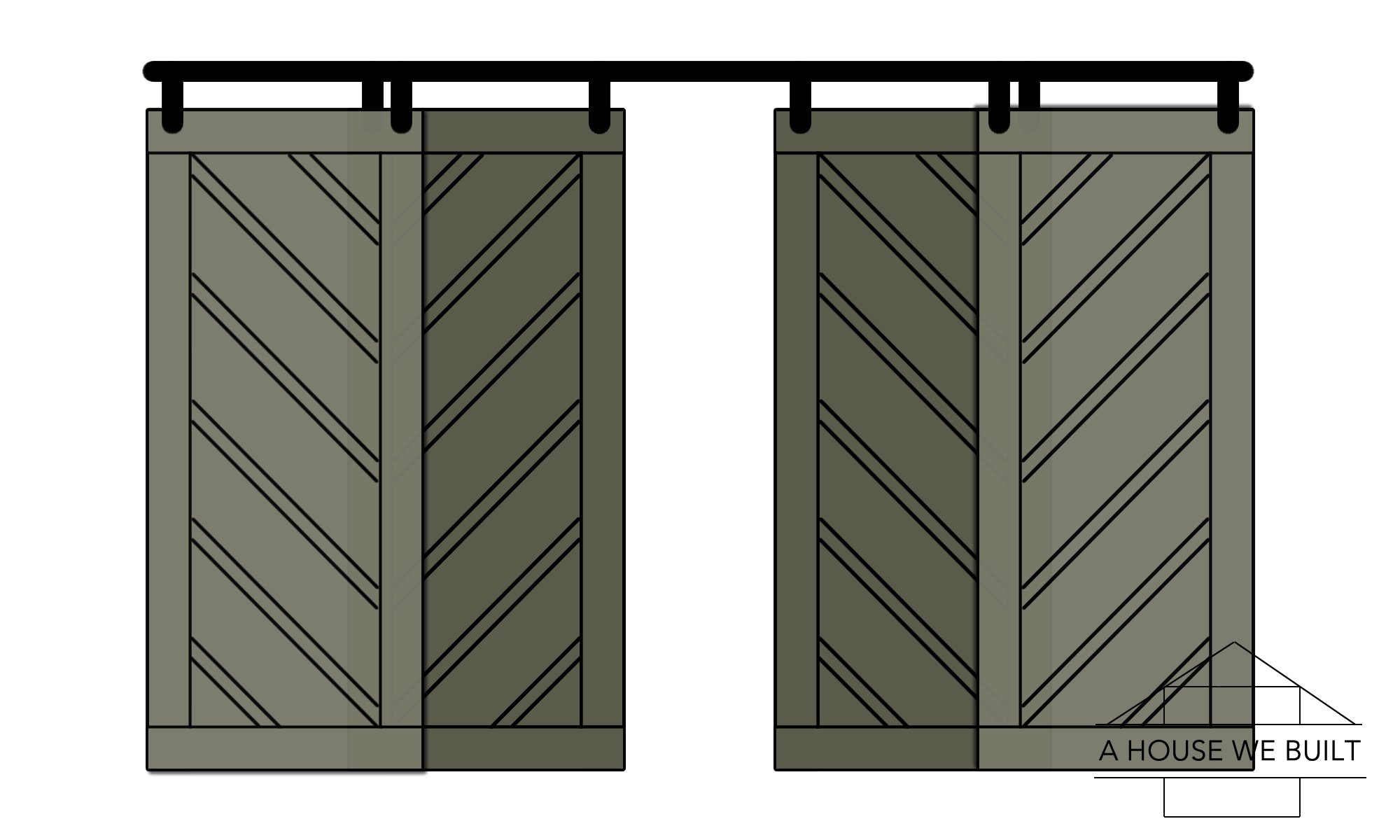
In real life, this is how that looks (cuz yep, we messed up the offset time around):
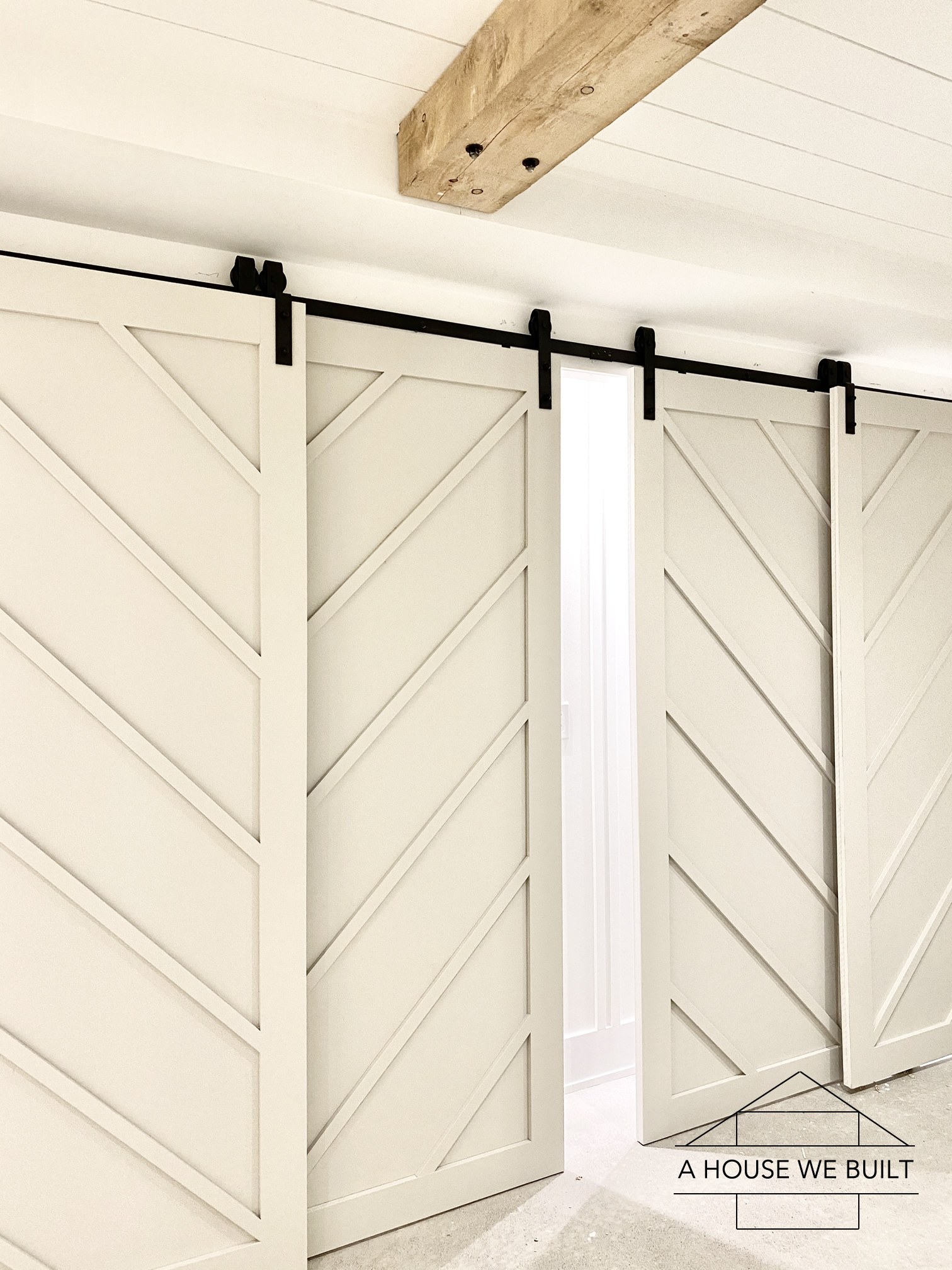
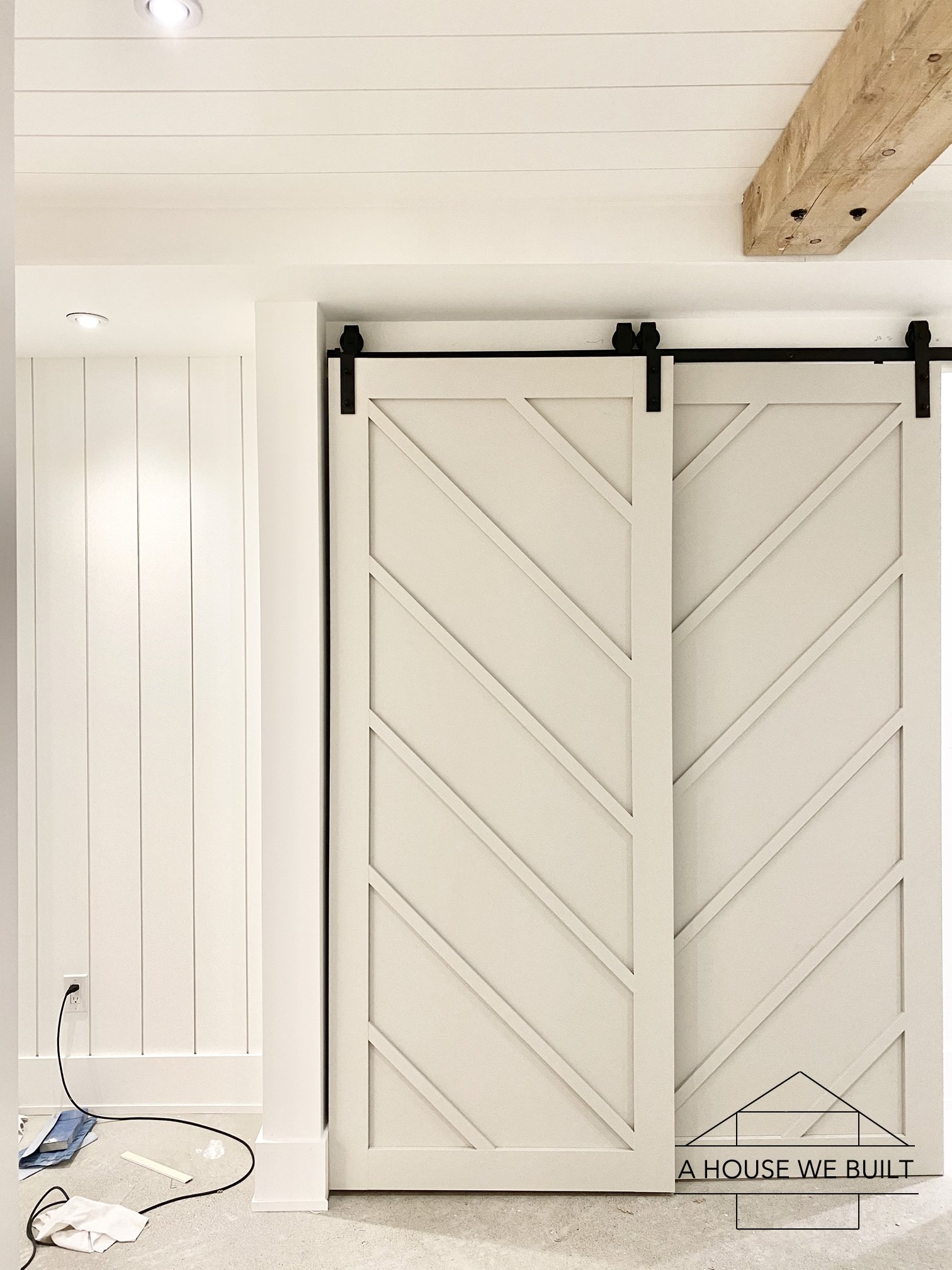
Note one: If you lot're working with double track bypass hardware, this isn't really a problem.
Note ii: If your door design doesn't have any perimeter trim (so, if information technology was all horizontal or vertical boards, or even a single-slab design), this wouldn't really matter. Or maybe some people wouldn't care, but for me, this situation was unacceptable because my design needed all 4 doors to be fully visible for the chevron pattern to flow properly from one door to the next. Not only were about vi-inches of Doors 2 & 3 visually lost when all the doors were the aforementioned size, but the worst part was that the battens no longer lined upward with each other because nearly 6 inches of Doors two & 3 were subconscious behind Doors i & 4.
My mistake was that in my excitement to build these barn doors, I didn't properly consider how much visual space my design would lose from the overlap before building the doors. Then, here was our solution:
We decided to rebuild the two middle "backside" doors and modify them to crook the difference. Visually, they'd await perfectly aligned, but in reality both of them would be different sizes. This is how we did it.
We calculated that the amount of visual width we were losing with the bypass system was 5 ane/two inches per door – but we were only losing information technology on the side of the doors that was backside the "front" doors. Pregnant that we needed to add together 5 1/2 inches to the left side of the center-left door, and we needed to add 5 1/ii inches to the right side of the middle-right door. Notation: your additional width measurements will differ depending on your door and space size so our math probably won't work for some other space.
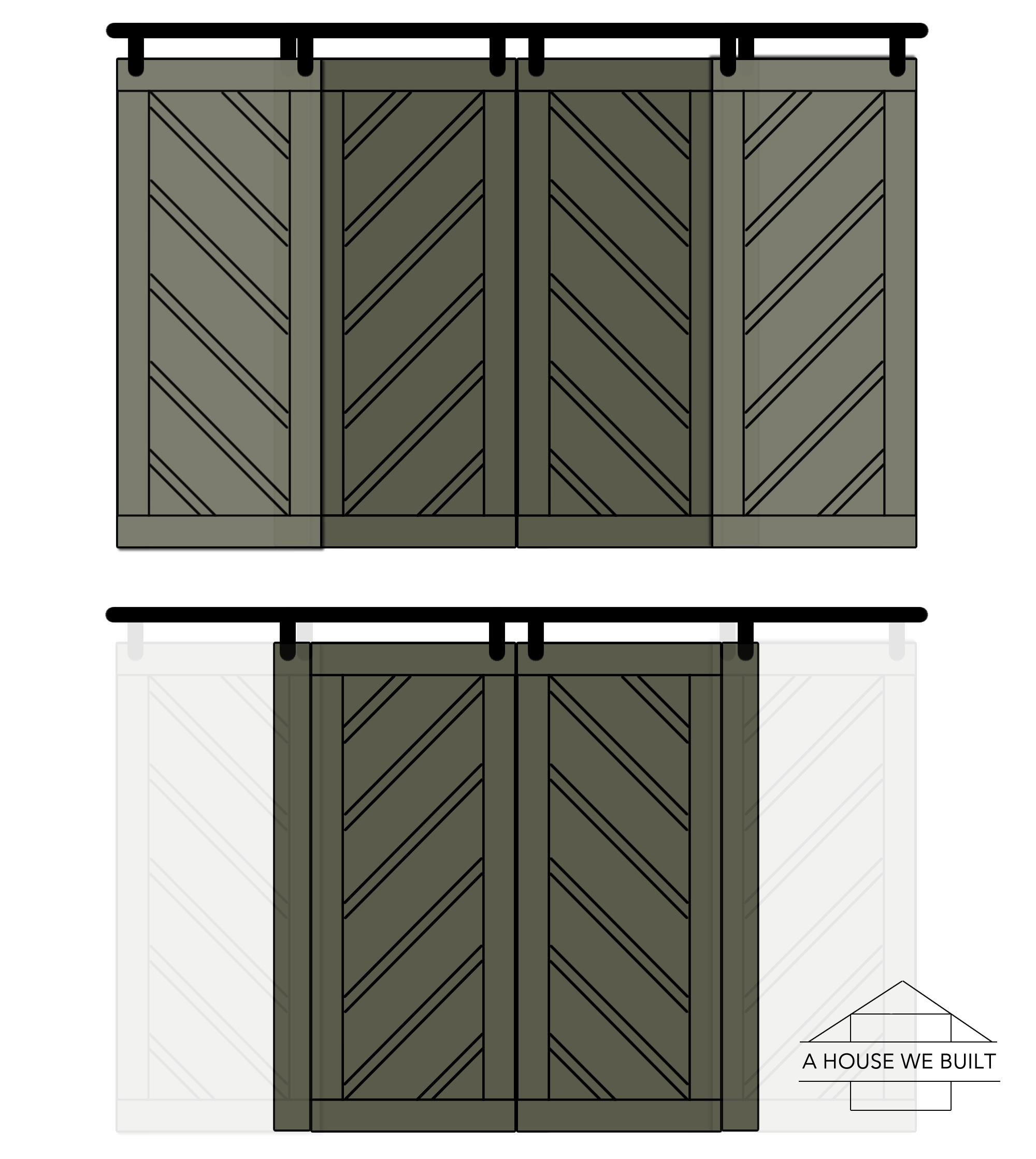
Rebuilding our "behind" doors (Doors 2 & 3) like this made the VISIBLE parts of the doors the same widths, but the subconscious additional widths allowed them to slide behind Doors i & 4 without hiding any of the chevron design and keeping the battens in line. (Note: If we had simply remade Doors 2 & 3 wider instead of only adding width behind the overlap, the batten alignment would mess up.) So…
- Doors one & 4 were aforementioned size (but opposite designs)
- Door 2 needed extra width on the left side to account for the overlap behind Door 1
- Door three needed actress width on the right side to account for the overlap behind Door 4
With 4 befouled doors, the angle of the battens has to switch each time like this: \\ // \\ //.
And if you do bypass barn doors in a different configuration (come across Options A, B, C, D above), it'll ever exist your "Behind" doors needing extra width anywhere a "Front end" door overlaps them.
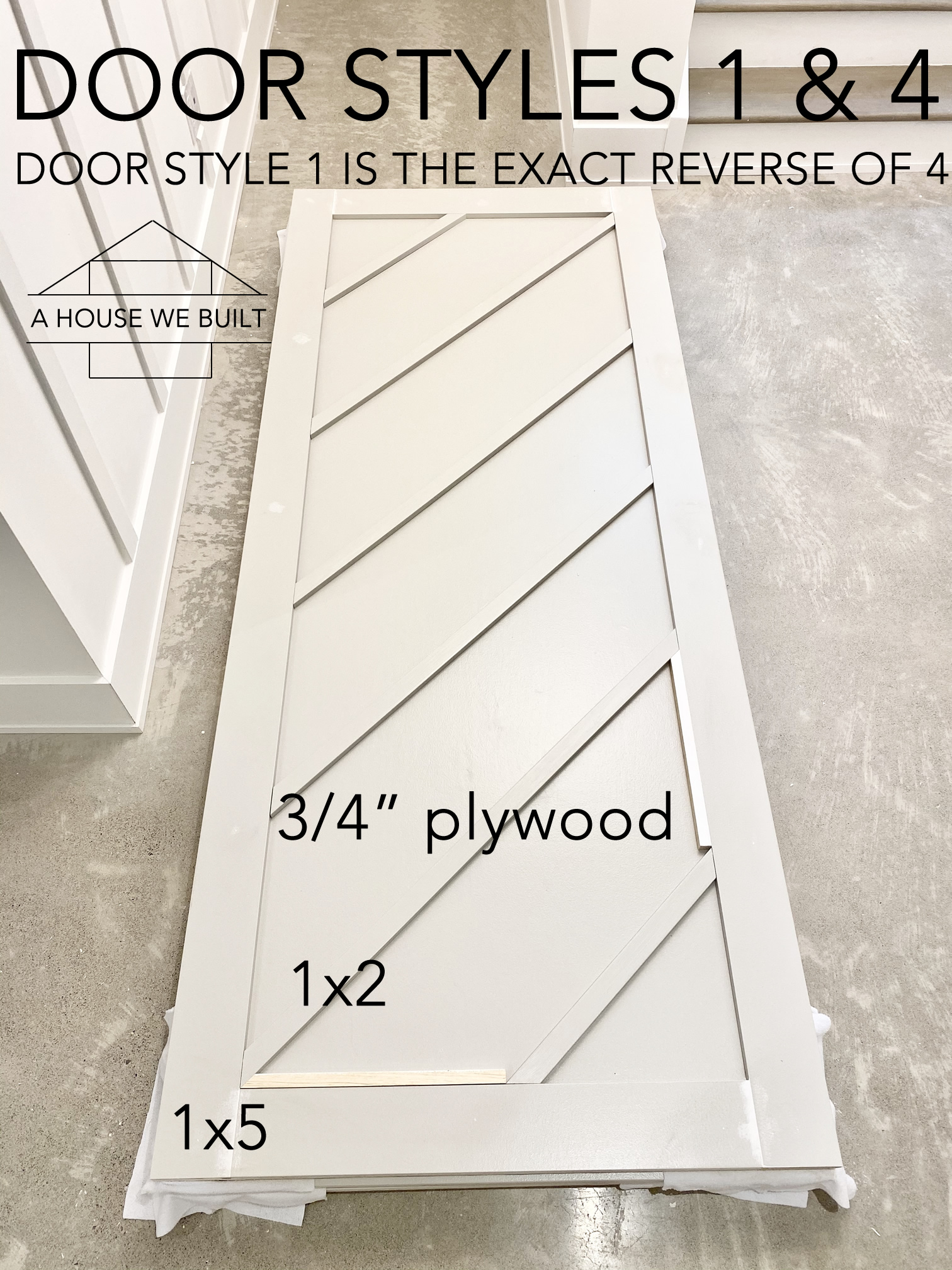
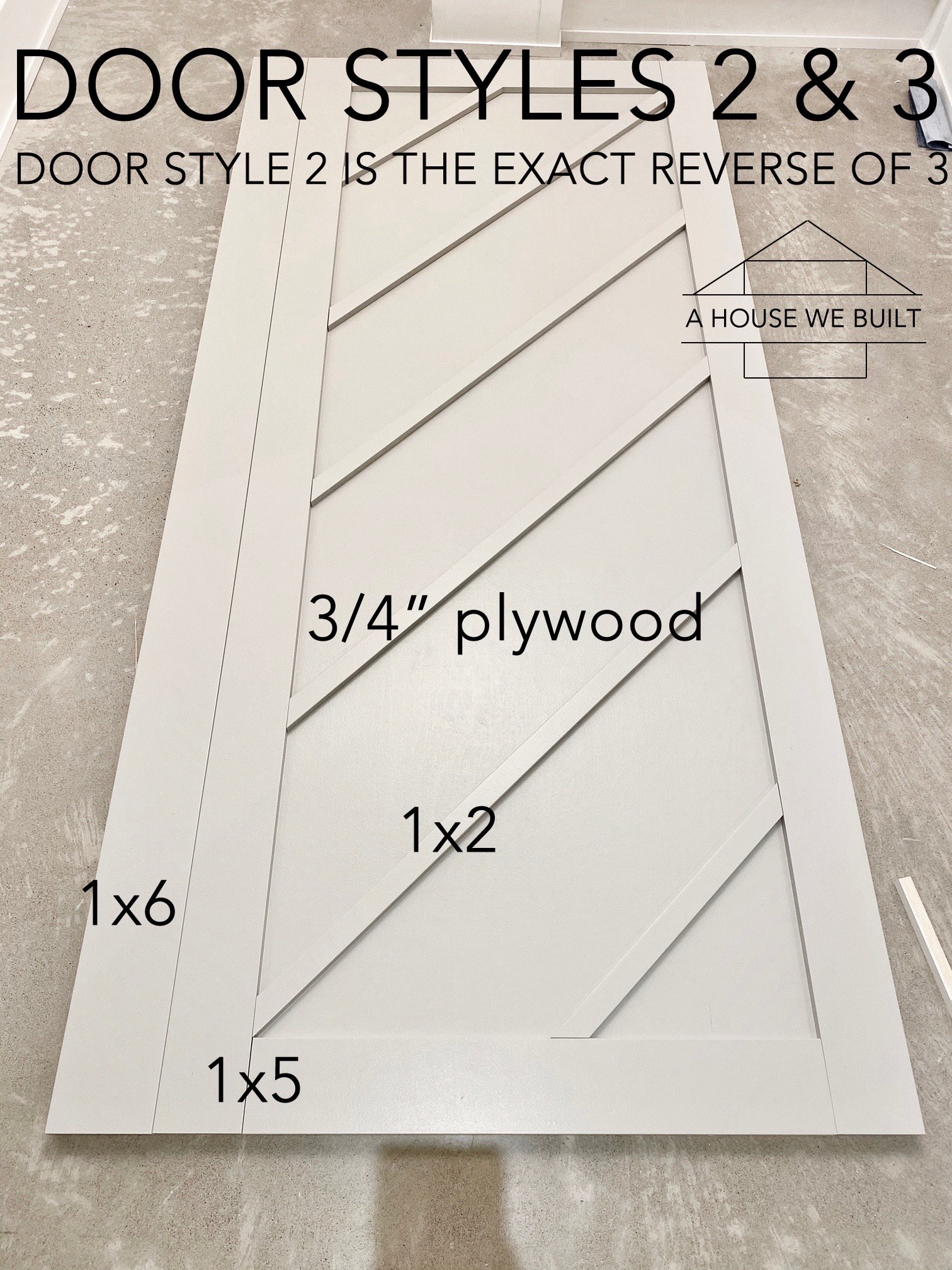

And hither is our solution in real life:


Luckily, nosotros had expert uses for our 2 "extra" barn doors – we ended up hanging them together as a single-rail double door characteristic flanking the entry to our master cupboard using a long rail and a double set of door hangers (like these: Habitation Depot | Dwelling Depot) so it all worked out in the end.
I really hope this all makes sense and is helpful for anyone thinking almost building bypass doors! 😀
Finally, here is a finished movie of our befouled door wall:
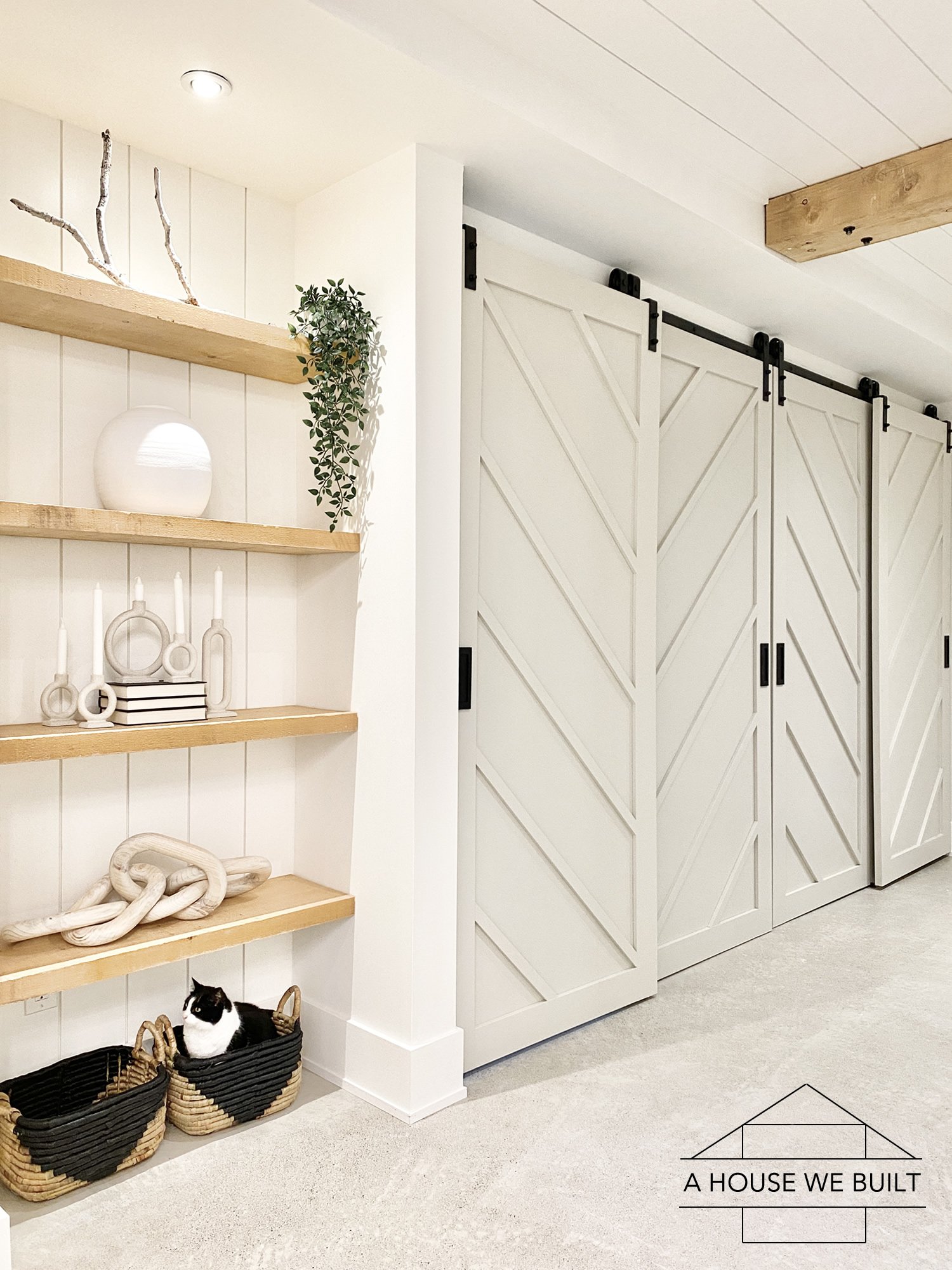
Sources: baskets | candle holders | woods links | like vase
Tutorials: Tutorial: How to Install Shiplap | How to Install Open up Shelving
For more of our tutorials, click hither.
For sources from our basement, click here.
To see other rooms in our house, click here.
0 Response to "Barn Door Bypass Hardware That Will Fit Any Door Thickness"
Post a Comment